#kung fu tea signature drink
Text

Kung Fu Tea Menu – America’s Largest Premium Bubble Tea Brand
The biggest bubble tea brand in America is Kung Fu Tea, a franchise that makes a variety of teas. Kung Fu Tea was established on April 30, 2010, in Queens, New York, and has since expanded to more than 250 sites nationwide
#food#foodlover#japanese food#foodstagram#food mention#foodie#cooking#recipe#fruits#desserts#cookies#kung fu tea classic tea#kung fu tea prices#kung fu tea signature drink#kung fu tea#kung fu tea near me#kung fu#kung fu tea menu with prices#kung fu tea classics#kungfutea
0 notes
Text
Kung Fu Tea Menu Prices [March 2023 Updated]
Kung Fu Tea is an American beverage company that is established in New York City, United States. The company is best known for offering a variety of tea and other beverages that are delicious enough to win everyone’s hearts. The Kung Fu Tea menu with prices is also reasonable enough for all the customers.
The Kung Fu menu includes hot drinks along with cold and iced beverages to cater to a wider audience. They also have seasonal drinks, specialty blends espresso, traditional beverages, and much more to make their menu list quite versatile. This article showcases the real Kung Fu Tea menu and prices so that when you look for ‘Kung Fu Tea near me’ you are well versed with their menu and prices.
Kung Fu Tea Menu Prices
Classic Tea Menu Prices
Classic Kung Fu Black Tea
$4.25
Classic Kung Fu Green Tea
$4.25
Classic Kung Fu Oolong Tea
$4.25
Classic Kung Fu Honey Tea
$4.25
Classic Winter Melon Tea
$4.25
Classic Winter Melon Green Tea
$4.45
Classic Honey Black Tea
$4.45
Honey Green Tea
$4.45
Honey Oolong Tea
$4.45
Honey Longan Jujube Tea
$4.45
Also Check Updated Morton’s Steakhouse Menu With Prices
Classic Hot Tea Menu Prices
Classic Hot Kung Fu Black Tea
$5.55
Classic Hot Kung Fu Green Tea
$5.55
Classic Hot Kung Fu Oolong Tea
$5.55
Classic Hot Kung Fu Honey Tea
$5.55
Classic Hot Winter Melon Tea
$5.55
Classic Hot Winter Melon Green Tea
$5.75
Classic Hot Honey Black Tea
$5.75
Classic Hot Green Tea
$5.75
Classic Hot Oolong Tea
$5.75
Classic Hot Longan Jujube Tea
$5.75
Yogurt Menu Prices
Yogurt Green Tea
$5.55
Yogurt Grapefruit
$6.05
Yogurt Orange
$6.05
Also Check Updated Serenitea Menu And Prices
Seasonal Special Menu Prices
Pumpkin Oolong Milk Tea
$4.85
Pumpkin Hot Oolong Milk Tea
$5.65
Hot Brown Sugar Ginger
$5.85
Milk Tea Menu Prices
Kung Fu Milk Tea
$4.85
Kung Fu Green Milk Tea
$4.85
Oolong Milk Tea
$4.85
Thai Milk Tea
$4.85
Almond Milk Tea
$5.15
Coconut Milk Tea
$5.15
Honey Milk Tea
$5.15
Honey Green Milk Tea
$5.15
Honey Oolong Milk Tea
$5.15
Winter Melon Milk Green Tea
$5.15
Rosehip Milk Tea
$5.15
Taro Milk Green Tea
$5.15
Taro Milk Tea
$5.15
Coffee Milk Tea
$5.15
Also Check Updated Spur Steak Ranches Menu Prices
Hot Milk Tea Menu Prices
Hot Kung Fu Milk Tea
$5.95
Hot Kung Fu Green Milk Tea
$5.95
Hot Oolong Milk Tea
$5.95
Thai Hot Milk Tea
$5.95
Hot Almond Milk Tea
$6.15
Hot Coconut Milk Tea
$6.15
Hot Honey Milk Tea
$6.15
Hot Honey Green Milk Tea
$6.15
Hot Honey Oolong Milk Tea
$6.15
Hot Winter Melon Milk Green Tea
$6.15
Punch Menu Prices
Honey Lemonade Punch
$4.65
Grapefruit Green Tea Punch
$5.15
Lychee Black Tea Punch
$5.15
Lychee Punch
$5.15
Mango Green Tea Punch
$5.05
Orange Green Tea Punch
$5.15
Passion Fruit Green Tea Punch
$5.05
Peach Oolong Tea Punch
$5.05
Rosehip Lemonade Punch
$5.05
Strawberry Lemon Green Tea Punch
$5.05
Strawberry Lemonade Punch
$5.05
Sunshine Pineapple Tea Punch
$5.05
Also Check Updated Argo Tea Menu With Prices
Milk Strike Menu Prices
Chai Milk Strike
$5.95
Ginger Milk Strike
$5.95
Original Milk Strike
$5.95
Oreo Milk Strike
$5.95
Matcha Milk Strike
$5.95
Red Bean Milk Strike
$5.95
Herbal Jelly Milk Strike
$5.95
Hot Milk Strike Menu Prices
Hot Chai Milk Strike
$6.95
Hot Ginger Milk Strike
$6.95
Hot Wow Milk Strike
$6.95
Hot Original Milk Strike
$6.95
Hot Oreo Milk Strike
$6.95
Hot Matcha Milk Strike
$6.95
Hot Red Bean Milk Strike
$6.95
Hot Herbal Jelly Milk Strike
$6.95
Also Check Updated Charley’s Philly Steaks Menu And Prices
Espresso Menu Prices
Signature Coffee
$4.25
Latte
$4.45
Mocha
$4.45
Cappuccino
$4.45
Caramel Macchiato
$4.45
Caramel Macchiato
$4.45
Pumpkin Coffee
$5.15
History of Kung Fu Tea
Kung Fu Tea is one of the most loved beverages company, that has nailed its position in New York City. New Yorkers often start their day with a cup of freshly brewed Kung Fu Tea. Along with delicious tea and other beverages, the Kung Fu restaurant menu serves mouth-watering foods to complement your experience at the store.
The first Kung Fu Tea store came up in Queens, New York in 2010. The founders Michael, Ray, Allen, and Sean started the company to serve the most delicious and authentic bubble tea in America. And without a doubt, Kung Fu Tea has emerged as one of the most loved brands of Kung Fu Tea in the United States.
Since its inception, Kung Fu Tea has expanded the love of bubble tea to other locations over the entire country. Currently, there are over 200+ locations of Kung Fu Tea in multiple American states. In 2018, Kung Fu partnered with Taiwan-based TKK Fried Chicken restaurant chain and included crispy and mesmerizing fried chicken in the Kung Fu Tea food menu.
Over the years, the Kung Fu Tea menu with prices has evolved a lot to meet the changing needs of customers. The brand ensures to have a fair and reasonable Kung Fu Tea menu price list so that customers get attracted to the menu as well as to the affordable prices.
Review of Kung Fu Tea
The Kung Fu Tea hours of operation vary from location to location however at most Kung Fu Tea locations, the store opens at 11 am and closes at around 7 in the evening. Their opening time might vary on weekends and holidays.
The Kung Fu Tea menu is filled with delicious choices of tea, coffee, herbal drinks, and other for a refreshing experience. Moreover, the Kung Fu Tea food menu caters to some yummazing TKK fried chicken and mouth-watering ramen to complement your experience.
Kung Fu Tea menu includes options like classic drinks with fresh flavors options like black tea, melon green tea, logan jujube tea, honey oolong tea, winter melon tea, and much more. These teas are iced and made with fresh ingredients for maintaining supremacy in quality.
When at Kung Fu Tea how can you not order their signature milk tea that is brewed with milk powder to form a creamy and fantastic texture? Options like rosehip milk tea, coffee milk tea, Thai milk tea, and almond milk tea are most ordered in the stores.
The authentic Kung Fu Boba Milk tea is something you just cannot afford to miss when you visit a Kung Fu Tea franchise. You can also have beverages like punch, slush, and seasonal drinks from their wholesome menu. Besides the Kung Fu beverages, the hospitality they offer is beyond praise as per the reviews of their customers.
Also Check Updated Papi Steak Menu Prices
How to Order Online from Kung Fu Tea Menu in Few Steps?
If you want to order online from Kung Fu Tea then you can do that with the help of Grubhub, Ubereats, Doordash, etc. Below I will show you some steps on how you can order online from Kung Fu Tea with the help of Doordash so that you can enjoy their yummy food items at your home.
You can also check the latest prices of Kung Fu Tea for different locations as the prices may vary from location to location.
- First, head over to Doordash and choose your nearest location.
- After selecting the location, the latest menu prices of Kung Fu Tea will be displayed for that particular location (here you can just check the prices of Kung Fu Tea based on your preferred location).
- Now, select all the items from the Kung Fu Tea menu and add them one by one to your cart.
- In the next step, go to checkout and sign in to your account if you have one or can easily create a new account.
- After successfully signing in, fill in the shipping details and payment details and confirm your order.
Kung Fu Tea Contact Information & Important Links
Official Website
kungfutea.com
Kung Fu Tea Menu
Check Here
Kung Fu Tea Locations
Check Here
Kung Fu Tea Careers
Check Here
Kung Fu Tea Franchise
Check Here
Kung Fu Tea Nutritional Information
Check Here
Kung Fu Tea Order Online
Order Here
Social Media Handles
Facebook
Visit Now
Instagram
Visit Now
Twitter
Visit Now
Kung Fu Tea Contact Info
Kung Fu Tea Corporate Office Address
Not Found
Kung Fu Tea Phone Number
Not Found
Kung Fu Tea Contact Page/Form
Visit Now
Conclusion
Since 2010, Kung Fu Tea has emerged as one of the most loved bubble tea brands in America. The boba-based drinks of Kung Fu have been the favorite of millions of customers who enjoy it every day at a fair Kung Fu Tea price.
Although the Kung Fu Tea franchise fee may vary from location to location. If you want to enquire about the Kung Fu Tea franchise price, you can visit their website.
So, what do you think about the above-mentioned Kung Fu Tea menu with prices? Whatever your response is, kindly share it with me in the comment section below.
Frequently Asked Questions Related to Kung Fu Tea (FAQs)
Who owns Kung Fu Tea?
In 2017, L. Catterton, a private equity firm took over Kung Fu Tea.
Is Kung Fu Tea a franchise?
Yes, Kung Fu Tea is an American-based beverage franchise primarily known for its bubble tea.
How much does Kung Fu Tea cost?
The Kung Fu Tea cost varies between $4 to $7.
How much is the Kung Fu Tea franchise?
The Kung Fu Tea franchise cost would vary between $142,000 to $422,000 exclusive of the franchise fee.
How many Kung Fu Tea locations are there?
The Kung Fu Tea locations are expanded to over 200 locations in the United States.
What is Kung Fu Tea known for?
As its name suggests, Kung Fu Tea is famous for top-quality bubble tea.
The post Kung Fu Tea Menu Prices appeared first on Everymenuprices.
Read the full article
0 notes
Text
Kung Fu Tea Menu and Price
Kung Fu Tea is a chain of tea shops that originated in Taiwan and has since expanded to many locations around the world, including the United States. The company is also known as signature boba (bubble) tea, which is a type of tea-based drink that typically includes sweetened milk and tapioca pearls. Read More
#fococonutwatercalories#fococonutwaternutrition#focococonutwaternutrition#focococonutwatermenu#focococonutwater
0 notes
Text
Trip to Taipei/Hualien/Taichung/Puli, Taiwan (Part 6)
Part 1 here (Hualien).
Part 2 here (Taipei).
Part 3 here (Taipei).
Part 4 here (Taichung/Puli).
Part 5 here (Puli).
Day 7
Day 7. The last full day of this trip. It’s a long day today, waking up at 8am in Puli, and ending up in Taipei.
We went to A-bao again for breakfast. We didn’t eat there though. We took out our food and ate at the bus station. This time, I got a beef burger. It’s not too bad, it’s what you’d expect out of an above average beef burger.

I also bought soya milk, which was again, diluted and terrible. I threw it away after drinking half of it.
We reached the farm around 9:45am. The farm is at the mountain top, so the wind is really cool and nice. But because the sun was up, there was the uncomfortable hot-cold feeling which I really dislike.
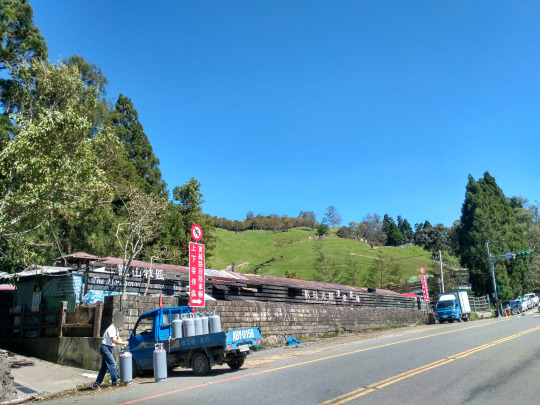

The first area is a food area. We would be coming back here for lunch later.
We bought the day pass tickets, which were NT$200 each.
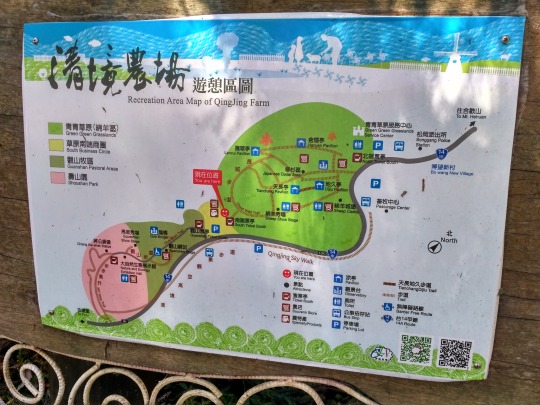
The person selling tickets told us there was going to be a Equestrian show soon at 10:45am, so we headed there first. Along the way, we saw a shop with bees flying all over freely.
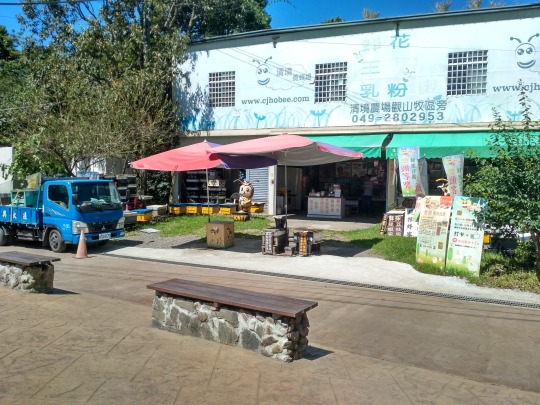
You can’t see the bees in the picture, but there’s easily a hundred bees flying all over the entrance of the shop. Eek.
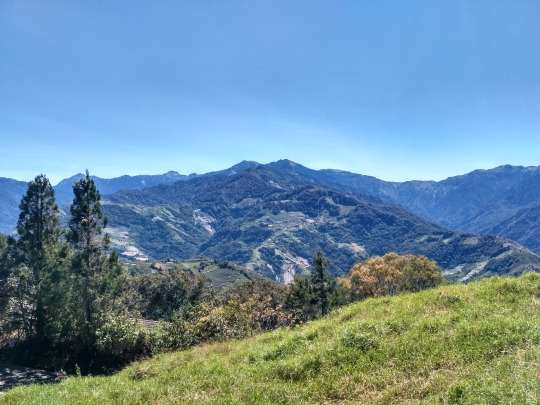
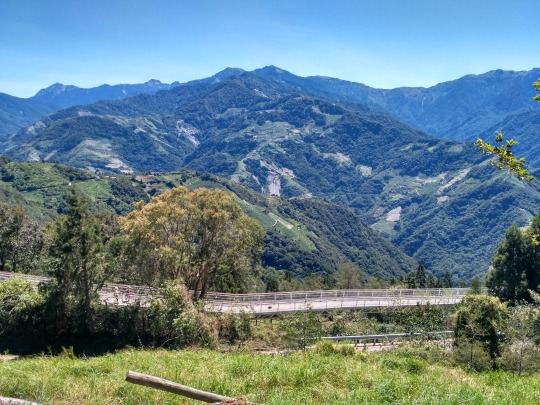
The view from the mountain top. Glorious.
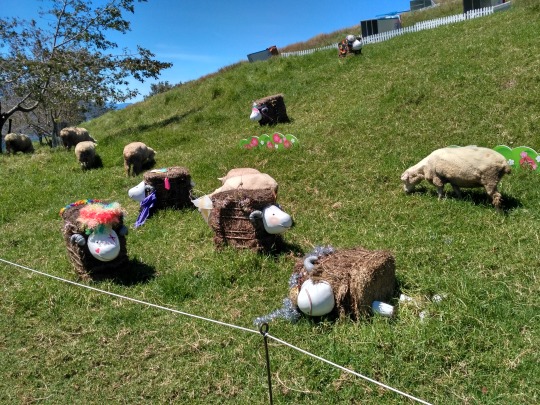

Sheep! Watch out for poop on the ground.
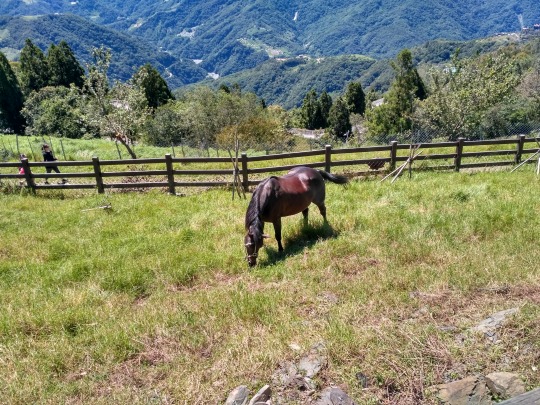
Horse!
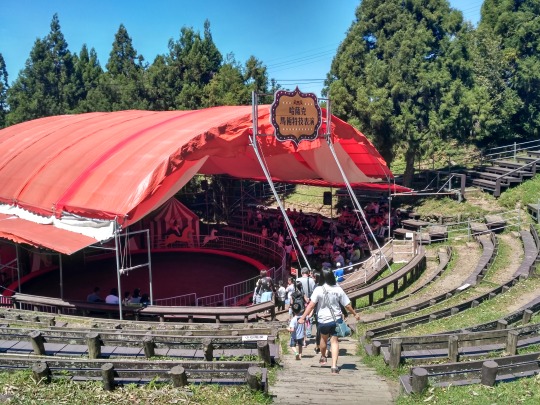
The equestrian show stage. We were 13 minutes early and fortunate enough to find some seats in the shade.

The emcee.
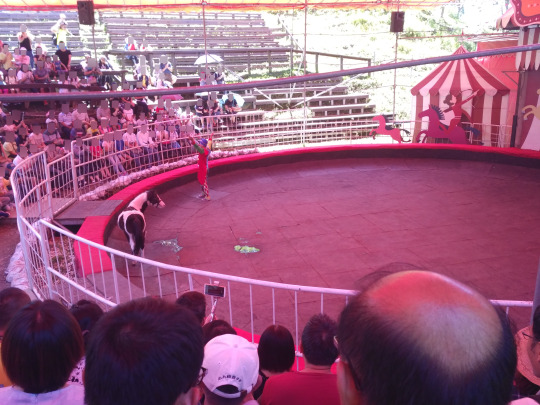
A clown and his pony. This was the starting act. He cycled on a unicycle first, asking the audience to throw some balls for him to catch with a net on a pole. Then he divided the audience into three sections, asking us to clap after he clapped. For example, if he clapped twice, then we would clap twice after he clapped.
Sounds dull, but being a clown and entertainer, he did it really well. Very amusing 😆
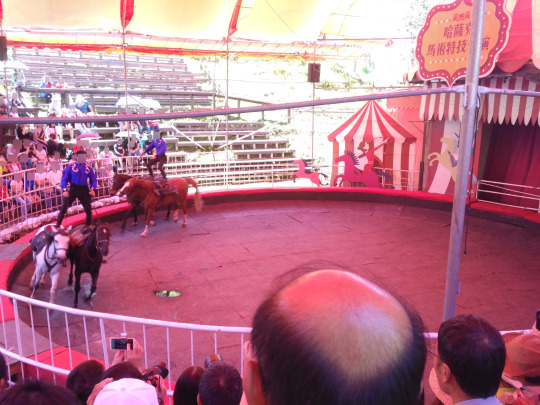
Then they moved on to a long segment of people performing stunts with their horses. It involved them standing on the horse, hanging upside down off the side of the horse, planking on the horse, getting off the horse onto the floor and jumping back on, and various other stunts. Later on a guy with a whip would stand in the middle of the ring, always staring at the horse and occasionally whipping the ground. It’s really loud. I guess it’s to scare the horses into submission or something? I have no idea.
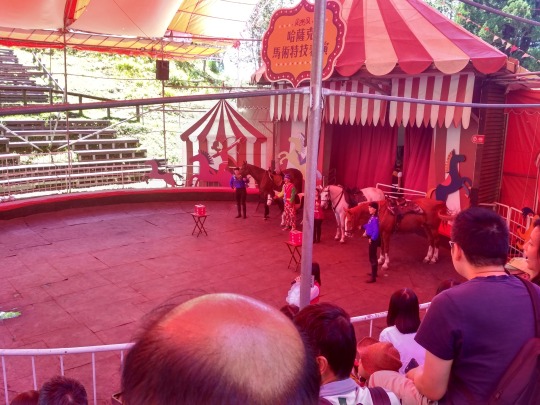
After all that, there was a photo taking session. You lined up in front of the horses and you could take pictures with them. The red boxes are for you to put money in if you want. I went to take a picture with the pony and the rightmost horse.
Then, we continued our explorations in the farm. We continued the path, which eventually led to the 487 step trail. It’s just a staircase with 487 steps. Fortunately we were going down.

Made it to the end! My right shoe at the hole in the cloth near the front. I have no idea when or how it appeared.
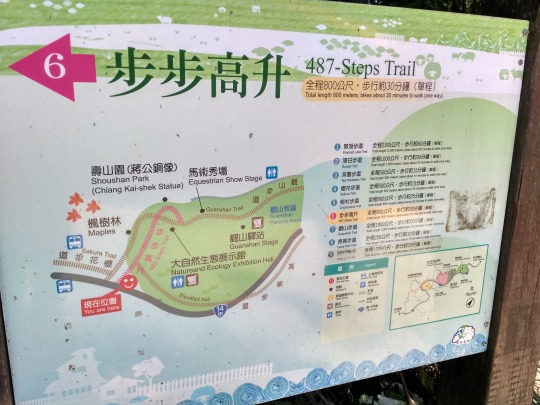
Unfortunately, the area to the left of the equestrian show stage has nothing worth seeing. After going down the 487 steps, we were left rather far from the area we started off from. The nice way back was an elevated, side of the mountain trail which cost NT$50 to enter, so we decided to walk on the road for cars instead. Really bad idea, in hindsight. It was hot, there was nothing nice to look at, the cars sometimes came uncomfortably close, and sometimes where were plants in the way. Icky.
We started walking up around 12pm, and reached the starting area at around 12:30pm. We decided to have lunch at the area with stalls I showed earlier.
After ordering, we decided that we wouldn’t have enough time to finish our food, and changed our order to take out. Then, we went to wait for the bus. It was due to arrive at either 1pm or 1:10pm, who knows. The Nantou bus timetables were all very inconsistent, we’ve noticed. They’re all done with pen/marker and paper.
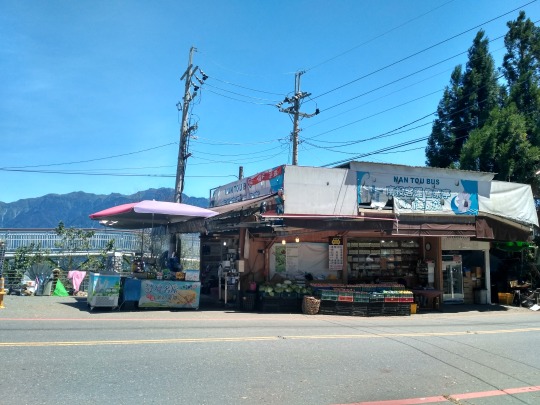
We decided to buy some goats milk egg rolls. They cost NT$100 for a pack of nine, wrapped in three packs of three each.
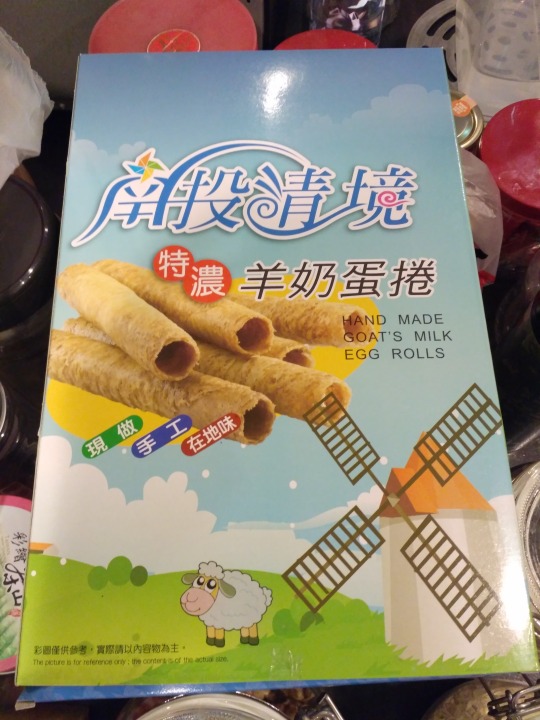
It’s not too bad, and because of its size and thickness, it’s much more flavourful than the love letters eaten during Chinese New Year.
As we didn’t know if we could eat on the bus, we waited until the bus was back in Puli before eating. We didn’t really have a place to go to eat, so we ate at the bus station, just like what we did for breakfast.

I ordered some chicken with rice thing. Again, the portions are so generous for the price. I think the food item just said chicken with rice, so I wasn’t expecting all the other items that came with it. I think this was NT$60 or 75 (SGD$2.65 to $3.32). I forgot again.
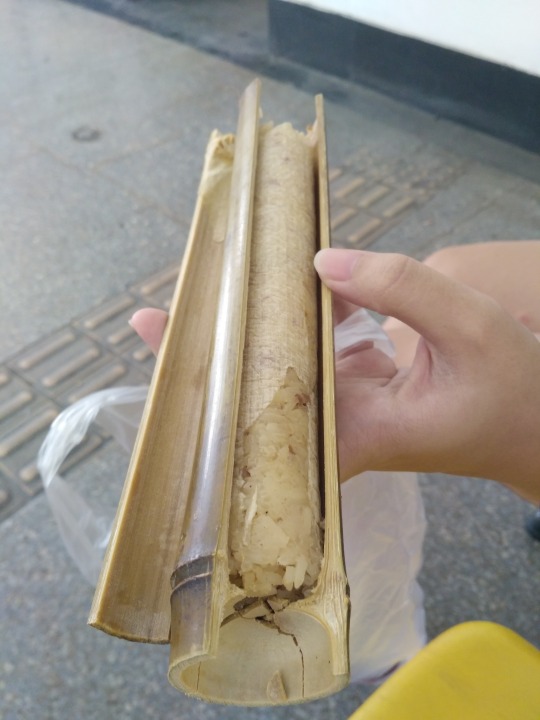
My friend bought bamboo rice. It’s served in bamboo. Pretty interesting.
After eating, we headed back to J House. I was feeling a little hot, so I bought another cup of pearl milk tea from that amazing shop yesterday. Just a small cup this time though. We called the guy to get our bags, and he offered to drive us to the bus station. What great service. If we had to walk to the bus station, we probably wouldn’t have been able to catch the bus to Taichung.
While getting into the car, I toppled my milk tea cup sideways, but not much spilled out since the only hole was the one from the straw. My friend gave me a tissue to clean it up and it was all good. Anyway, he drove us to the old bus station at first, which might have made us lose our bus. But somehow, we didn’t miss the bus. The bus was really crowded though. The driver had to count empty seats remaining to see if we could board. Ack.

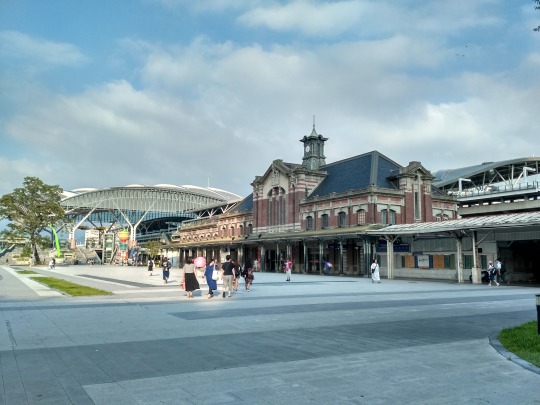
Back in Taichung! The bus dropped us off near Taichung train station. I wonder why they don’t board people at the same place.
It’s 4:50pm now, and we wanted to visit two places. Chun Shui Tang’s original store, and the Painted Animation Lane. Since Chun Shui Tang was on the way towards the Painted Animation Lane, we headed there first. While planning the trip, we also wanted to go check out Miyahara Ice Cream, which was really near the station. I’m not sure why we didn’t go. Too tired to think of it, I guess. Argh.

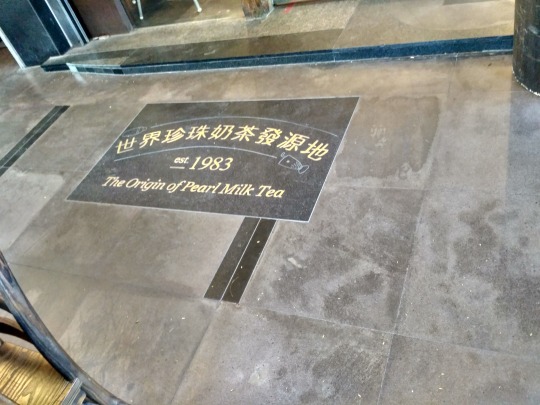
The origin of pearl milk tea.
It’s 5:17pm now, and my friend made a good point that the sky darkens rather early in Taiwan, so we decided to go to the Painted Animation Lane first.
The Painted Animation Lane is basically a lane with many drawings and paintings of anime, cartoons, and games. I took a picture of every single drawing there, but I’m not going to show all of them.
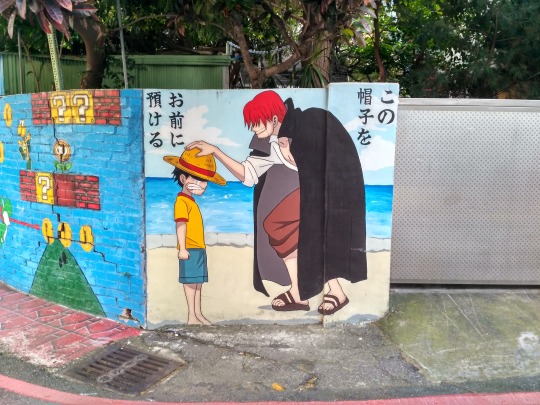
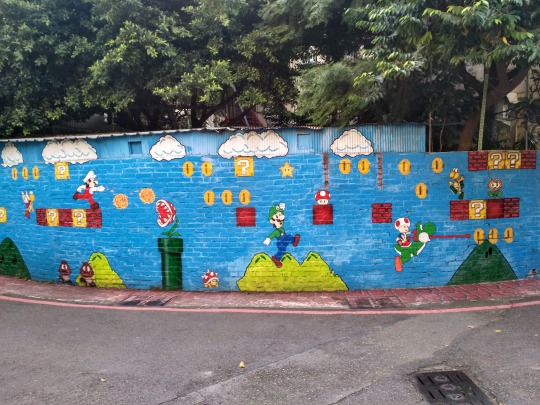
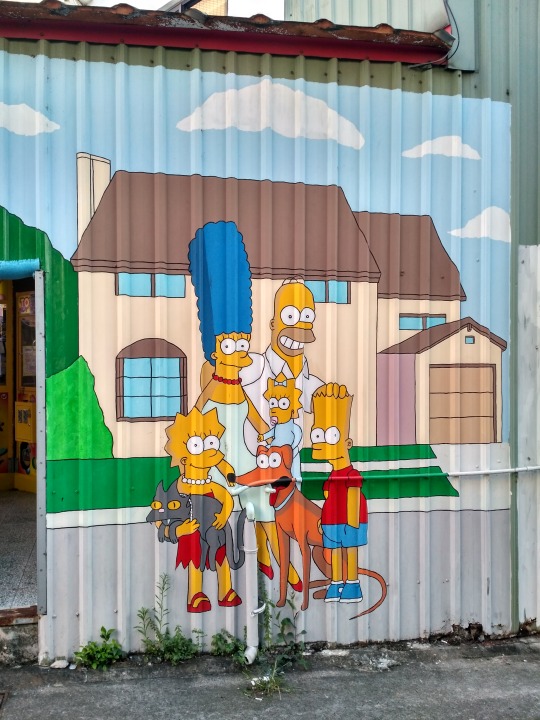
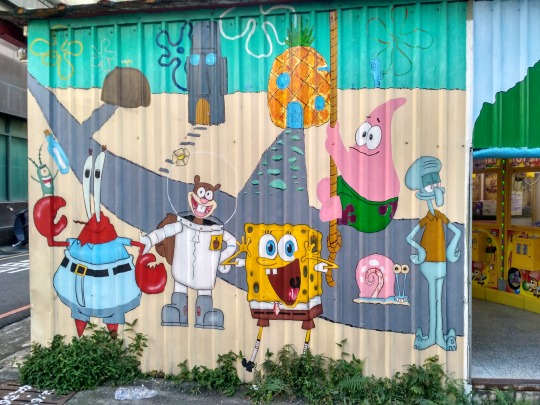
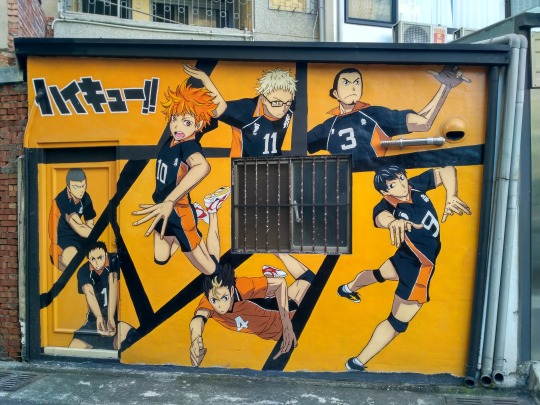

There’s a random adult item in this claw machine. Lol why.
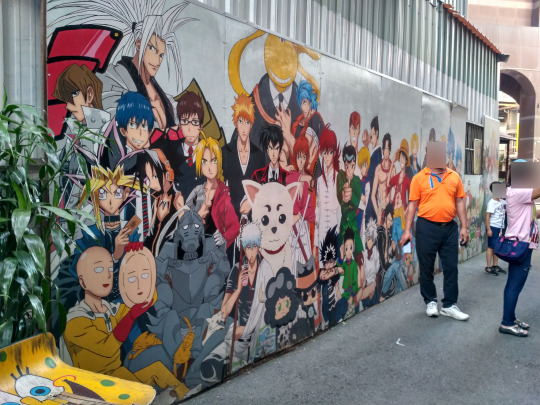
I don’t know why I didn’t take a panorama of this wall. Instead, I took 5 separate pictures of it, moving sideways slowly. Facepalm.

This isn’t the actual Totoro bus stop. There’s one further south of this place, which is an actual tourist attraction.

At the end of the lane, some guy who was working at a motorbike shop told us we could come in to look. There’s a huge Luffy statue here (worth NT$150,000/SGD$6,644), and a huge figurine collection. There was also a work in progress drawing. Apparently everything is his son’s. Pretty cool.
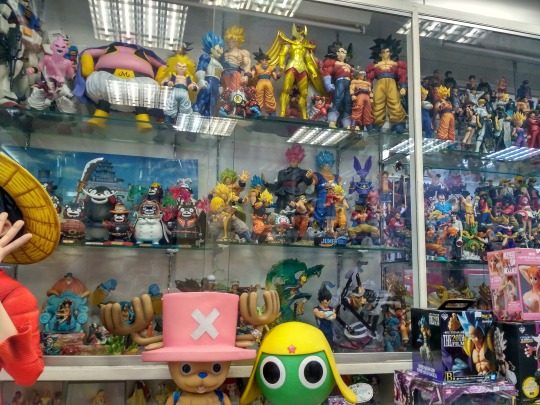
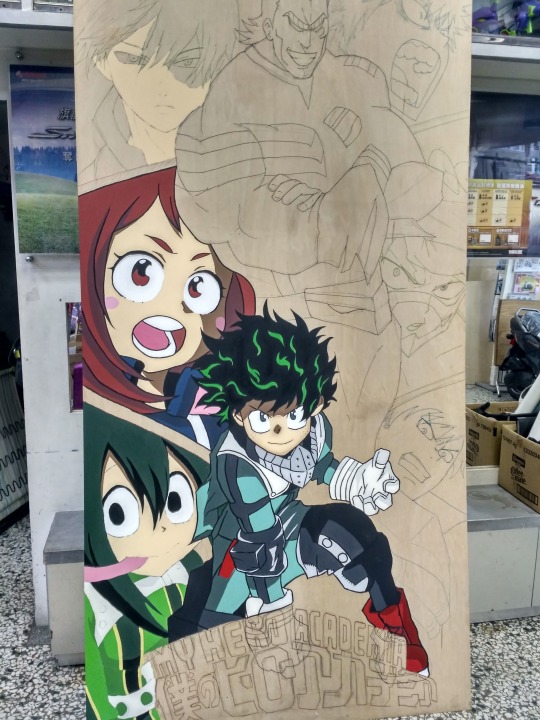
Anyway, that was it for the Painted Animation Lane. Now, back to Chun Shui Tang.
We reached Chun Shui Tang around 6:20pm. There were no seats at the ground floor, so we were led to the basement. I was told that I could leave my luggage at the ground floor, which I did. I went to retrieve it 10 minutes later as I wasn’t comfortable leaving it there alone. There are no valuables in there, but I would be really sad if all my merchandise was stolen. I mean, clothes are easily replaceable. Merchandise isn’t. Not in Singapore, especially.
I ordered sesame oil noodles, along with one of my friends. My other friend ordered Kung Fu noodles. They also ordered a pot of tea, while I ordered the pearl milk tea. How could you not drink the pearl milk tea at the place where it originated?
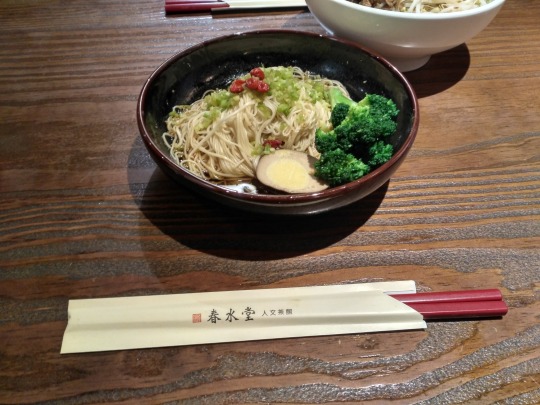


To be honest, the pearl milk tea was kind of a disappointment. The one near J House is better. The pearls here were a little hard, and I chewed on one that was harder than the rest. Inconsistent. The milk tea wasn’t as good either.
After the meal, I ordered their Signature Black Tea to go. This was also where cold black tea originated from, so I made it a point to try it as well.
Now, a walk back to Taichung train station. It was finally time to make the trip back to Taipei. It’s 8:20pm now, the day doesn’t seem to end. I was already quite tired before reaching Chun Shui Tang, and I could smell an unpleasant odour from myself. Ugh. The typhoon has passed, and it was a very hot day. There was barely any cloud cover (look at the farm pictures, the skies are so clear).

Anyway, it’s a long trip back. First a walk to Taichung train station, then a train to Taichung High Speed Rail station, then another train to Taipei Main Station, and then a walk to the hotel. We didn’t get our tickets until we reached Taichung High Speed Rail station, and fortunately there were still available seats. We weren’t able to sit together though (it was a two-one split). The train departed at 9:31pm.

My Signature Black Tea. I still haven’t drank it yet. And I dropped it on the floor while on my way here. I was wearing pants without pockets, which made my life really difficult. I already had to use one hand to pull my luggage, so accessing my phone, tickets, passport, etc. was really a pain 😭. I should have drank the tea much earlier. It’s now just warm.
11pm. We were finally at the hotel. We booked a four star hotel this time (all the previous lodgings were three star), but it was roughly the same price as all the other places we stayed at. That’s exactly why we booked it.
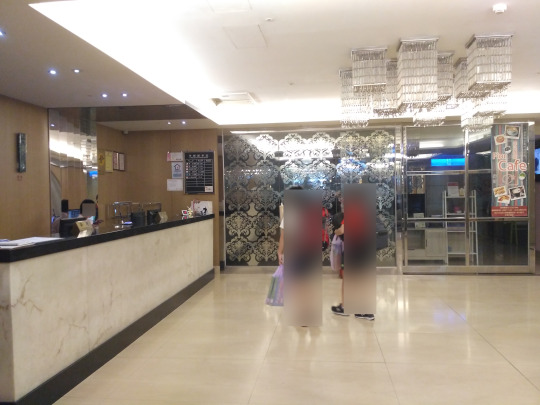

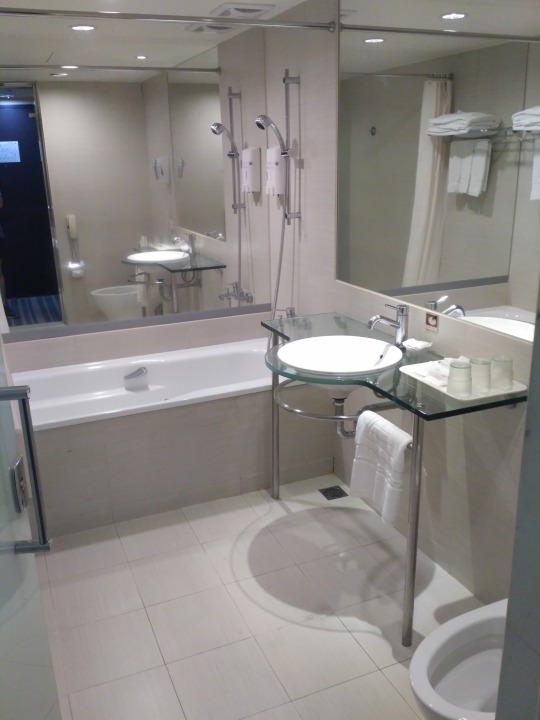
I put my black tea in the fridge and went to bathe five minutes after we got into the room. I really needed a refresher. After bathing, the tea wasn’t cold, and I just gave up and drank it. It’s actually pretty good.
Our room was in the middle of the floor, so there were no windows. Instead, there were fake windows and fake lights.

Since there was a bathtub, my friend went to play in it. I was wondering if that friend would fall asleep in the bathtub and drown, a trope commonly seen in anime 😅
Day 8
Last day in Taiwan. Our flight was at 3:25pm, so we couldn’t wake up too late. We decided to wake up at 9am. My friend ate cup noodles for breakfast, since it was bought on the first day in Taiwan in Hualien’s supermarket. It was originally meant to be a night snack, but we kept eating dinner at such a late time that snacking wasn’t required.
We walked out of the hotel and randomly turned down one street in search of breakfast. The hotel had breakfast, but it wasn’t free, and from reviews, it wasn’t good.
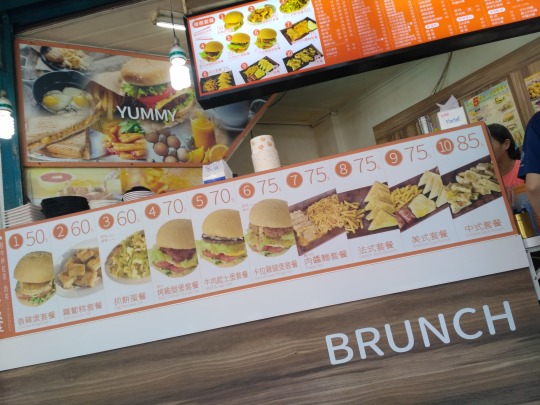
We ended up here. I ordered a chicken burger. Again, can’t go wrong with fried chicken. I don’t know how it’s so good everywhere.
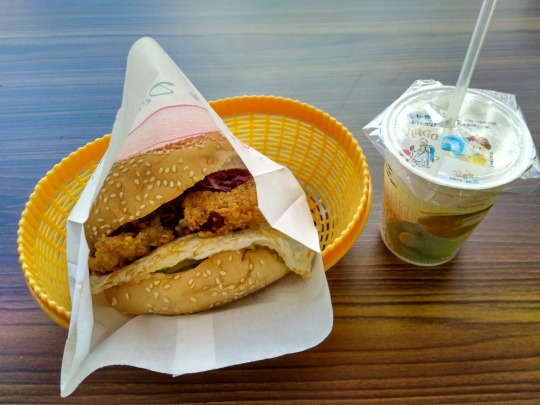
I also ordered a cup of soya bean. They’re both pretty good. I mean how can it go wrong? I guess if you order soya bean from A-bao, it can.
My friend ordered some hot soupy thing, which took forever to eat. I was melting in the sweltering heat so I decided to go back first. They wanted to go to a supermarket they saw on the way, so I decided to go there first instead.
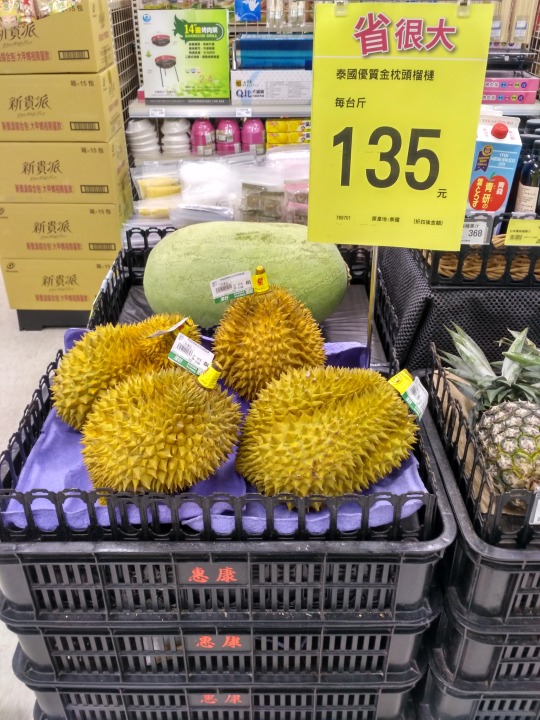
Durians, and that’s a watermelon behind. I notice watermelons in Taiwan are all these strange elongated types. I’ve never seen such watermelons before.

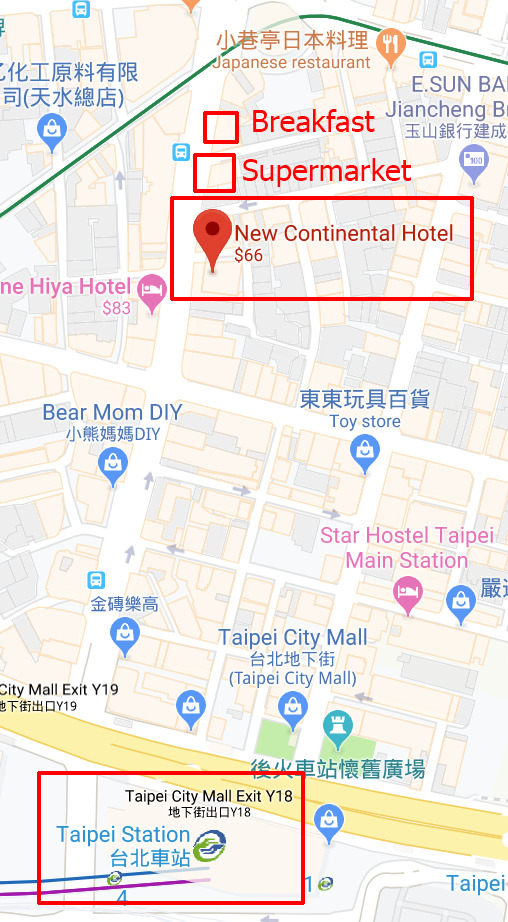
After this, we checked out and headed to Taipei Main Station. We decided there was some time left and went to explore the mall on the other side of the station. My friend bought pineapples cakes, which are the typical food souvenir you buy whenever you go to Taiwan. I also bought a pearl milk tea keychain for NT$80. I have no idea why. I wasn’t actually interested until I realized that the pearls and milk tea in it could move. Anyway, there wasn’t many other shops of interest there, and we only had 15 minutes, so we left after a short while. Now, it’s time to head to Taoyuan Airport.
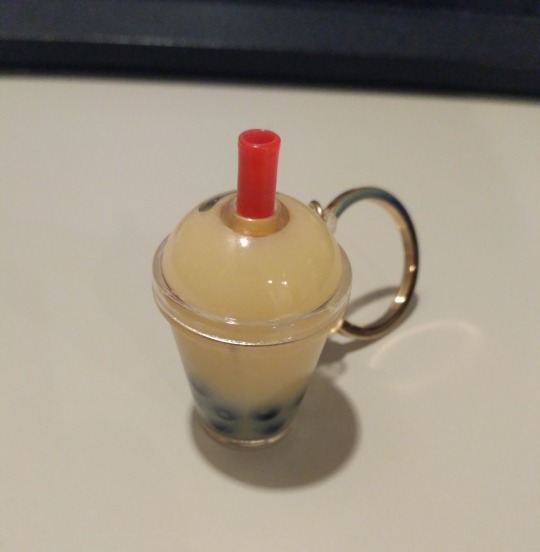

Pretty views from the train.
We soon reached the airport. I had to check in my luggage as all our items were over the combined weight of 21kg (7kg per person). I didn’t really want to check it in as I didn’t want to wait for my luggage to appear after I landed, but ah well.
We haven’t had lunch yet, and the plane was due to reach Singapore at 8:15pm, so I decided I need to eat something hearty. We went to the airport food court, and I ordered ramen. Not worth it for the price. It was 2:25pm when I got my food, which meant that I had to gobble down my food. Not good. My friend ordered Dan Dan Noodles and pearl milk tea, and also had to gobble the noodles down. The tea was brought into the security check area, and my friend was told to finish the drink before proceeding 😅
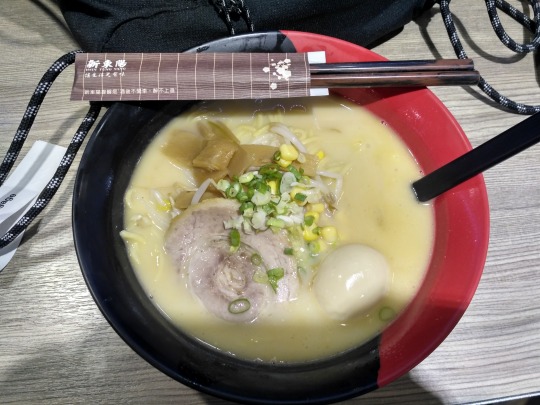
We walked fast to the boarding gate, and reached around 3:05pm. They were calling for passengers to board, and the waiting area was totally empty. This has to be the first time I’m so late to board a plane 😅
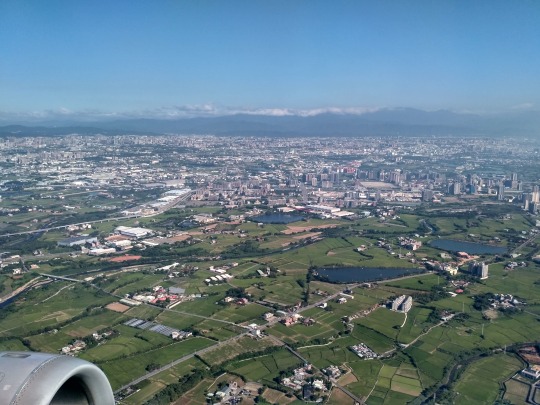
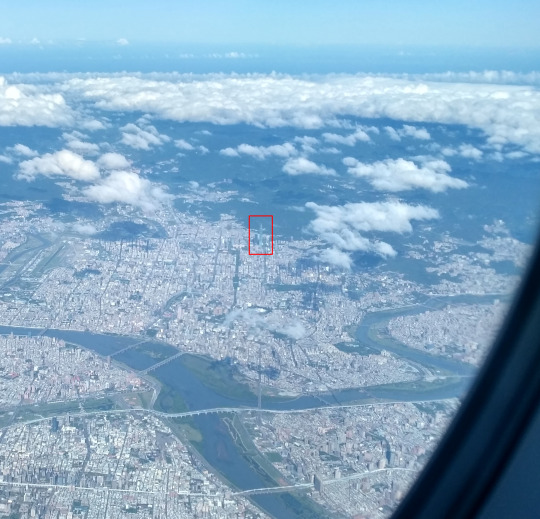
Is that Taipei 101? Who knows. The plane flew at this altitude throughout the whole flight. If there weren’t any clouds, you could see the land or ocean easily.
We soon landed at Changi Airport Terminal 1. One of my friends wanted to shop at the duty free shop, so that one left. Another of my friends had family waiting outside, and didn’t want to make them wait, so that one left too. We didn’t go out of the arrival hall together 😢
Anyway, terminal 1 arrival now exits to the Jewel. I didn’t know that. This is my first time at the Jewel, and I quickly and easily found the fountain in the middle. Pretty nice, I guess. I managed to take a panorama while the lights changed, so there’s two colours in the photo.
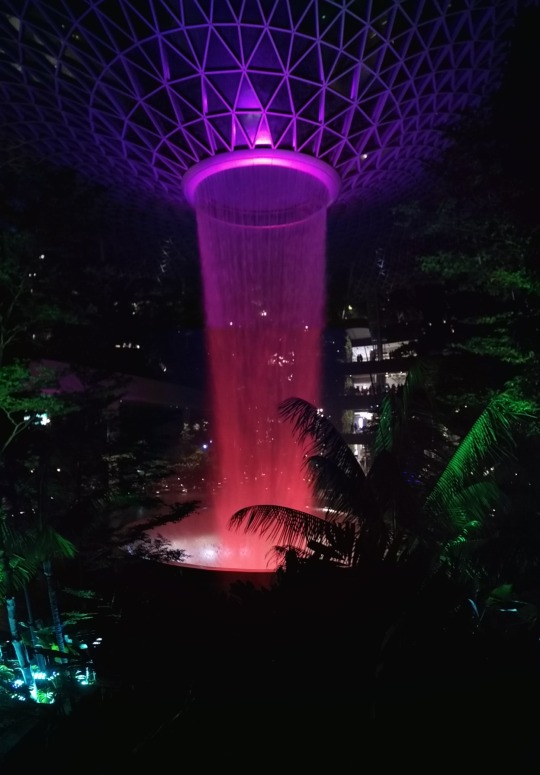
I haven’t had my dinner yet, so I was looking for food. I headed to A&W first, but the queue was still long, so I went to Subway. The prices seemed to be inflated, as I don’t remember the prices being so high. Higher prices for an expensive shopping mall, I guess. I went to Burger King next, and the cashier seemed really busy and I didn’t want to bother.
I ended up at BreadTalk, and they were having an offer of three buns for $5. I bought my buns, found a taxi, and went home.
The end.
Part 1 here (Hualien).
Part 2 here (Taipei).
Part 3 here (Taipei).
Part 4 here (Taichung/Puli).
Part 5 here (Puli).
1 note
·
View note
Text
What’s New at Epcot This Week: Guardians of the Galaxy and Ratatouille Construction, Mission Space Restaurant, Cuties, and Christmas Kringla!
Just like Hollywood Studios, there are lots of exciting things coming to Epcot in the near future! Between two new attractions, the Skyliner, Epcot International Festival of the Holidays, and two new table service restaurants, we have more than a few updates for you this week.
The Imagination Pavilion
Want to know more about what we found in Future World and around the World (Showcase)? Let’s go!
Spaceship Earth
What’s New Around the Epcot Entrance
When we arrived, the first thing we noticed was some new construction walls near the bag check area at the park entrance.
Construction Near Epcot Entrance
Construction Near Epcot Entrance
What’s New at Joffrey’s Coffee and Tea Company
Joffrey’s Coffee and Tea stands throughout Epcot are now offering Mickey’s 90th Birthday Blend Coffee.
Joffrey’s Menu
Joffrey’s says it’s “rich & smooth, forever a classic.”
Joffrey’s Mickey’s Birthday Blend Coffee
What’s New in Future World
From snacks to coaster construction, there was plenty to discover in Future World this week!
Guardians of the Galaxy Coaster
See that construction progress on the Guardians of the Galaxy coaster?
Guardians of the Galaxy Attraction Construction
Panels started going up on the building this week.
Guardians of the Galaxy Attraction Construction
Check out this view of the Guardians of the Galaxy ride building from across the World Showcase!
Guardians of the Galaxy Attraction Construction
Read up on all the construction updates here!
Electric Umbrella
To go along with the adorable Gingerbread Mickey Straw, the Electric Umbrella is offering a new cookie: the Chocolate Overload Cookie!
Chocolate Overload Cookie at The Electric Umbrella
It’s a chocolate chip cookie with caramel and white chocolate drizzle, plus crispy pearls. Ooooh!
Meet Ralph and Vanellope
There’s a new character meet and greet in town: Ralph and Vanellope from Wreck-it Ralph 2: Ralph Breaks the Internet!
Ralph
Ralph and Vanellope
Read all about it here!
The Land Pavilion
Since it’s the holiday season, let’s start with dessert. Sunshine Seasons in The Land has a beautiful new holiday cupcake!
This apple spice cupcake with apple buttercream is $5.49 or one Disney Dining Plan Snack Credit. It looks EXACTLY like the one we reviewed several years ago here!
Holiday Cupcake at Sunshine Seasons
Apple Spice Cupcake — Cross Section
Not feeling an apple cupcake? No worries: this quick service stop is still offering the Belle, Peanut Butter & Jelly, Rose Gold, and Vegan cupcakes.
Dessert Case at Sunshine Seasons
The new seasonal Cheddar Bacon Soup is perfect for those chilly days.
Seasonal Cheddar Soup with Bacon at Sunshine Seasons
And, with the Chef’s Special Sticky Sesame Pork Ribs, there’s no way we were leaving hungry.
Stick Sesame Pork Ribs at Sunshine Seasons
Outside at the nearby snack stand, Cuties have arrived!
Cuties available at The Land snack cart
These juicy little mandarin oranges are $4.50 or one Disney Dining Plan Snack Credit for a 3-pack.
Cuties available at The Land snack cart
Fountain View
There’s a bubblegum wall, there are bubblegum wall ears, and now there’s a bubblegum wall ears crisped rice treat over at Fountain View! Check out the full post here to learn more.
Spaceship Earth Krispy Treat
We also spotted some new tumblers. Is that Mickey as Dreamfinder!? Read more about the tumblers here.
Epcot Starbucks Tumbler
The Starbucks Collection ornaments have arrived, too.
Starbucks Ornaments at Fountain View
Mission Space Restaurant
Over near Test Track, we noticed even more new construction!
Mission Space Restaurant Construction
Could it be the site for the anticipated Mission Space restaurant – “Space 220“? We think so!
Mission Space Restaurant Construction
We’re looking forward to seeing how this new restaurant shapes up!
What’s New in the World Showcase
While the 2018 Epcot International Festival of the Holidays is in full swing, we found a few surprises in the World Showcase.
Mexico
La Cantina de San Angel has three new margaritas on the rocks: La Cantina Classica, Blood Orange, and Patron Loco.
Menu at La Cantina
We tried the Patron Loco and Blood Orange. Are they not the perfect holiday colors!? Stay tuned for the full review.
Patron Loco and Blood Orange Margaritas
Meanwhile, across the way at Choza de Margarita, there were also some menu updates. Their Signature Margaritas have new names!
Updated Menu at Choza de Margarita
The Smokey Jalapeño is now the Fuego Verde, Lime Cucumber is now Piñata, Acan Grapefruit will be known as the Mayan Mule, and the Passion Mango Frozen Margarita has become Mango Loco. A new drink called La Choza Classica has been added, and the Guava Pink Peppercorn Margarita has been removed.
Updated Menu at Choza de Margarita
Norway
At the Kringla Bakeri og Kafe, the Pumpkin Spice Kringla are now beaming with red and white holiday sprinkles!
Seasonal Kringla
These Christmas Kringla are, of course, seasonal, and you can get one for $5.99 or one Disney Dining Plan Snack Credit.
The cast member told us they’re still pumpkin spice though — not peppermint or anything.
Seasonal Kringla
China
At the Joy of Tea, we noticed some exciting new menu changes! Food & Wine Festival favorites Kung Fu Punch and Ritzy Lychee have been added. The Milk Cap Lychee Tea, a specialty item that has been available for a few months, also now appears on the permanent menu!
Joy of Tea Menu
Germany
The miniature train village in Germany is all decked out for holidays, too. See the candy cane train?
Holiday Train Cars
If you look closely, you’ll also notice that the village appears to be celebrating Festival of the Holidays, too!
Germany Train Village
Read the full story and see more pics of the train village here.
Not quite ready to let go of pumpkin spice season? We get it. Weinkeller has you covered. Their current specialty spirit is Mozart Chocolate Cream Pumpkin Spice, and you can buy a bottle or experience a 2 oz shot.
Mozart Pumpkin Spice at Weinkeller
America
Unique snacks are back at Heritage Manor Gifts!
Heritage Manor Gifts
Find all sorts of treats like chips, peanuts, and animal crackers.
And, if you fall in love with the Heritage Hot Cocoa from The American Holiday Table Holiday Kitchen, you can make your own at home with the help of this mix.
Get all the details on the new eats here!
American Heritage Chocolate
Japan
It was a beautiful day in the Japan Pavilion!
Japan Pavilion
The pavilion’s new, Signature Dining table service restaurant has broken ground and construction is underway.
Construction in Japan
The worksite is right next to the Mitsukoshi Department Store.
Construction in Japan
A timeframe for the opening date hasn’t yet been announced, but you can count on Disney Food Blog to keep you posted (join our free newsletter here!). In the meantime, check out that view of Spaceship Earth across the World Showcase Lagoon!
View of Spaceship Earth from the Japan Pavilion
France
Lots happening in the France Pavilion these days! Construction is underway for both the Disney Skyliner Gondola System and Remy’s Ratatouille Adventure.
Remy’s Ratatouille Adventure and Skyliner Construction
Construction walls are up near France’s garden and the gazebo.
Remy’s Ratatouille Adventure Construction
Check out these cheerful Holiday Macaron Ice Cream Sandwiches we spotted at L’Artisan des Glaces!
Christmas Macarons
United Kingdom
Cuties have replaced the seasonal fruit at the Yorkshire County Fish Shop in the United Kingdom Pavilion. Here, they’re $4.19 or one snack credit.
Yorkshire Fish Shop Menu
Canada
The Pecan Maple Bark has finally arrived at Canada’s popcorn cart! This treat is on the Festival of the Holidays menu, but it wasn’t yet available when the festival first began. Get yours now for $8.50.
Pecan Maple Bark Sign at the Canada Pavilion Popcorn Stand
And that’s everything we spotted that’s new at Epcot this week!
Join the DFB Newsletter to get all the breaking news right in your inbox! Click here to Subscribe!
Have you seen something new or fun on your Disney adventures? Be sure to tag us @DisneyFoodBlog on instagram!
Related posts:
Tips From the DFB Guide: Do I Need Advance Dining Reservations During the Epcot Food and Wine Festival?
21 Myths About Walt Disney World Food DEBUNKED
This Turtle Brownie in Epcot is SO MUCH AWESOME.
from the disney food blog https://ift.tt/2KNslGE
via https://ift.tt/LNvO3e
0 notes
Text
Shanghai: Insider Travel Guide
(CNN)Welcome to the future.
This is the best of Shanghai, home to more than 20 million residents, 6,000 high-rises (and growing) and a constant chorus of jackhammers.
It’s a city striving to set all the benchmarks for the modern world.
The commercial hub was developed by far-sighted European traders 160 years ago and it remains the destination for people who can’t wait to experience tomorrow today.
Our best of Shanghai guide shows you how to enjoy the sprawling city’s — past, present and future. And, yes, there’ll be enough fun even for visitors who suffer from vertigo.
Beijing: Insider Travel Guide to China’s fascinating capital
Hotels
Luxury
Waldorf Astoria Shanghai on the Bund ()
The Waldorf Astoria occupies one of Shanghai’s oldest buildings: the restored 101-year-old former Shanghai Club.
With giant chandeliers, neo-classical ceiling carvings and original marble floor tiles shipped from Sicily a century ago, the interior feels more like a royal palace than a hotel.
Most of its 260 rooms are located in the newly built 24-story tower. Many deliver unobstructed view of Lujiazui’s skyscraper forest.
Rooms are decked out in nostalgic American style, with modern plush touches such as large walk-in closets, Herms bathing amenities and digital TVs embedded in the mirrors.
The hotel’s historic Long Bar (34 meters from end to end) mixes the city’s top-notch cocktails.
Park Hyatt Shanghai ()
Currently the highest hotel in mainland China, the Park Hyatt provides the best angle to view Shanghai: from the top.
Occupying the upper part (79th-93rd floors) of the 492-meter Shanghai World Financial Center, all 174 rooms enjoy stunning vistas overlooking Lujiazui high-rises, the Huangpu River or the Puxi downtown area.
Interiors follow a streamlined Chinese style with earth-tone furniture and outsize bathrooms that include a one-square-meter walk-in rain shower.
The hotel lobby is on the 87th floor.
On the 93rd floor, Music Room bills itself as the world’s highest nightclub.
Mid-range
Hengshan Picardie Hotel ()
Located in a protected historic building, this best of Shanghai hotel is for travelers who want to trade Lujiazui’s gridlocked avenues for the tree-lined streets of the former French Concession.
The 15-story, 259-room Picardie sits opposite Xujiahui Park, one of the best locations in town to observe China’s unique park culture: you’ll see massive exercise groups at dawn and a public dancing spectacle at dusk.
It’s also a quick stroll from Shanghai’s traditional bar district on Hengshan Lu, the shopping district of Xujiahui and Metro Line 1.
Hotel Equatorial ()
One of the first hotels in Shanghai built to receive international travelers after the Chinese economy opened up to world trade, the 520-room, four-star lodging is in the thick of things.
It’s a few steps away from Nanjing Xi Lu (ground zero for high-end shopping) and the fabulous Jing’an Temple, a 780-year-old Buddhist shrine.
Two metro lines and the Yan’an Lu elevated highway are right outside, so guests can zip to any part of the city quickly and without hassle.
URBN Hotel (URBN)
This 26-room boutique hotel in downtown Jing’an District was once a post office and now claims to be China’s first carbon neutral hotel.
The renovation, which was completed using 100 percent locally-sourced and recycled materials, has won numerous awards for its sustainability and design.
Located on a local street, across the road from one of Shanghai’s best little tonkatsu joints, URBN is popular with visitors looking for innovative design and a green feel, with rooms over-looking a courtyard and bamboo garden.
The food and beverage options are also none to shabby at URBN, with its Downstairs restaurant serving up delicious weekend brunch options accompanied by a mean Bloody Mary.
Pentahotel Shanghai ()
For starters, the check-in desk is attached to a bar. Right behind the front desk, there’s a pool table.
Pentahotel’s lobby also includes a caf, a games room and a restaurant.
Guests tend to chill and socialize in Wi-Fi-covered areas.
All 250 rooms are fitted out in a minimalistic style with views over downtown residential buildings.
The hotel is near three metro lines.
Budget
Jinjiang Inn ()
This no-frills hotel chain provides all the basics for a short stay for the price of a few drinks in a ritzy bar.
Location is superb for the price. The 159-room inn is within walking distance of many tourist attractions, such as Old Town, People’s Square, Huaihai Zhong Lu and Xintiandi.
It’s also at the south end of Yunnan Nan Lu, one of Shanghai’s original food streets with some of the city’s yummiest shengjian (fried dumplings) at Da Hu Chun (, 71 Yunnan Nan Lu, near Jinling Dong Lu).
The budget hotel brand operates at some 85 branches all over Shanghai, from commercial zones to airports and railway stations.
Jinjiang Inn (Huaihai Zhong Lu branch), 293 Yunnan Nan Lu, near Huaihai Dong Lu; +86 21 6326 2200; rooms from RMB 289 ($45)
Shanghai: The city that changes the way you see the future
Dining
Fu 1088 (1088)
This Shanghainese restaurant is housed in a 1930s colonial villa.
Instead of a dining room, guests eat in private rooms furnished with antiques.
On a menu of tweaked Shanghainese specialties, diners will find everything from traditional hongshao rou to creamy huangyu (yellow croaker) noodle soup served in a mug.
Modern dishes include goose liver poached in sake.
Shanghainese food critic Shen Hongfei () recommends the crab with egg white, a delicate, creamy dish brought to the table in an actual eggshell.
Jesse ()
With its curmudgeonly waiters and tiny, crowded dining room, the original Jesse location on Tianping Lu isn’t just a meal, it’s an experience.
Rica Lou, dining editor at Ganlan magazine, calls the original Jesse her “hands-down favorite Shanghainese restaurant.”
It’s the creamy crab roe potato soup that wins her over every time.
Shen Hongfei votes for the Shaoxing-wine-marinated crab, a best of Shanghai dish that’s popular with locals.
For an appetizer (or dessert), the xin tai ruan is a sweet dish of red jujubes stuffed with soft, glutinous rice cake.
Two of Jesse’s signature dishes, the eight treasure duck and green onion fish head, require 24 hours notice.
Yi Long Court ()
This Peninsula restaurant cooks some of the best Cantonese dishes in Shanghai.
“It’s so rare to see such classic Cantonese food,” says Shen Hongfei.
“It’s flavorful and light and it’s almost like the food prepared for the managers of Thirteen Factories [an 18th-century foreign trade zone in Guangzhou].”
One of Shen’s favorites at Yi Long Court is beef with oyster sauce, which is “a long-lost classic Cantonese dish.”
To make the most out of the meal, book the eight-seat chef’s table, prepared by executive chef Dicky To.
Xin Da Lu ()
Peking duck is the star at this Chinese regional restaurant.
The Hyatt recruited two Beijing master chefs and lugged a seven-ton brick oven from the capital especially to roast the ducks to crisp and lacquered perfection.
The open kitchens allow diners to admire the shining fowl roasting over a fire of fruitwood logs before they’re brought to table, sliced and served with sugar for dipping.
Xin Da Lu, Hyatt on the Bund East Building, 199 Huangpu Lu, near Nanxun Lu; +86 21 6393 1234 ext. 6318
Hai Di Lao hot pot ()
Tea, fruit plates, Wi-Fi, board games, shoeshines and even manicures are provided to customers for free.
Enthusiastic staff keep waiting diners upbeat.
The restaurant chain boils hot pot 24/7.
The meal itself embraces a staggering choice of vegetables, meat and seafood that diners cook themselves in a bubbling pot of broth placed in the middle of the table. Hot pot soups range from super-spicy to plain and diners get to DIY their dipping sauce.
The hand-pulled noodles are prepared tableside with a kung fu-style noodle dance.
The brand hosts a virtual dining service in two locations in Shanghai and Beijing.
Fu Chun Xiaolongbao ()
Xiaolongbao is Shanghai’s favorite snack food and everyone in Shanghai has an opinion about where the best xiaolongbao in town can be found.
There are many excellent options around town, but many visitors unfortunately usually end up at tourist traps in Yu Gardens, or at chains such as Din Tai Fung.
A very respectable example of the specialty can be had from Fu Chun, in the downtown Jing’an District.
Popular with locals, this place is perpetually busy with diners ordering Fu Chun Xiaolongbao (RMB 6 for six dumplings) and Crab Roe Xiaolongbao (RMB 16 for six dumplings) in ample quantities.
Fu Chun Xiaolongbao, 650 Yuyuan Lu, near Zhenning Lu; +86 21 6277 0701
Qibao food street ()
During public holidays, massive crowds of travelers swarm Qibao Old Street for a view of the canals, or to snap that atmospheric photo of morning haze dancing around the neighborhood’s scenic bridge.
But for locals, day trips to the water town are about one thing only: food.
Numerous hole-in-the-wall restaurants along the 400-meter-long street sell an extensive assortment of local snacks, from xiaolongbao to stinky tofu to tuang tuan.
Ultraviolet in Shanghai — 1 table and 22 courses
Nightlife
Flair
Flair is the crowning glory of the Ritz-Carlton Shanghai, Pudong.
The rooftop bar’s interiors were created by Japanese design gurus Super Potato, but the real draw is the terrace.
Standing approximately 250 meters in the sky, this is the highest bar terrace in the city, with tiered sofa-seating that looks onto the financial district’s skyscrapers.
Drinks cost RMB 80 and up for cocktails. Sashimi is flown in daily from Japan.
When the skies are clear, call ahead to book a table and ask if there’s a minimum spend that day.
M1NT
This plush club/bar/restaurant remains a favorite of the city’s beautiful people.
It takes up the 24th floor of a building between People’s Square and the Bund and affords staggering views toward Pudong or Puxi city center.
Shark tanks run the length of the entrance, while uniformed waiters and bartenders shake up pricey drinks (RMB 80-120 for cocktails).
The door staff often turn away non-members when it gets crowded, so it doesn’t hurt to dress up or call ahead to book a table (minimum spends of around RMB 5,000 often apply).
The Apartment
Since opening in 2010, The Apartment has become one of the most popular bars in Shanghai.
It takes up two floors plus a roof garden in the center of the former French Concession and attracts a crowd that’s upscale without being pretentious.
In the daytime, the rooftop is a leisurely place to eat and sip wine — drinks cost RMB 50-80.
At night it gets rammed with cocktail-sipping, well-dressed Chinese and foreign guests, and stays that way until 4 a.m. or so.
JZ Club
This dim, smoky room is the go-to place for jazz aficionados in Shanghai.
Inside, it’s like a Parisian bar from the 1950s: a cluster of small round tables spilling out from a low stage, with a long bar at the back and a gallery up top.
There’s live music here every night, from Gypsy jazz to swing and blues.
Drink prices are around RMB 50 for wine and RMB 70 for cocktails.
This best of Shanghai nightclub fills up on weekends so come early — or very late — if you want a table.
Cashbox Partyworld ()
The best of Shanghai sports many flavors of karaoke bar (or KTV, as they’re known), from seedy to five-star.
Cashbox is somewhere in the middle — fun, inexpensive and hugely popular with a young crowd.
The Fuxing Park branch is next to a couple of Chinese clubs. On weekends, it swarms with well-dressed youths.
Guests book private rooms that seat eight to 20 people. Bring your own drinks or order beer and spirits from the house. Rooms run around RMB 200 per hour, depending on size and number of guests.
Cashbox Partyworld, 109 Yandang Lu, near Fuxing Zhong Lu; +86 21 6374 1111
No. 88 (No.88
This chain of bars is wildly popular in many of China’s second- and third-tier cities and since they opened their first Shanghai incarnation it’s become apparent that the formula works wonders in the big smoke as well.
Simply take some insanely gawdy decor (think a cross between Willy Wonka’s factory and a pirate ship), add flashing lights, tipsy people looking for a good time, an emphasis on bottle service and a setlist of top 40 remixes and you can’t lose.
No. 88 Bar, 2/F, Wujin Building, 291 Fumin Lu, near Donghu Lu; +86 21 6136 0288
6 ways Shanghai is different than the rest of China
Shopping
Taikang Lu ()
Crowds of tourists, artists, hipsters and fashionistas pour into the tiny longtangs (Shanghainese alleyways) of Taikang Lu to experience Shanghai’s bohemian charm.
The area represents a traditional Shanghainese residential form, shikumen (“stone door houses”), and is now a half-commercial complex selling everything from tailored qipao to French wine.
Souvenirs are overpriced, but the ambience is worth sampling.
Locals still live in some of these buildings — travelers can see elderly people chatting each other or middle-aged women hanging laundry outside.
Taikang Lu between Sinan Lu and Ruijin Er Lu
Dongtai Lu antique market ()
For anyone visiting Shanghai with time for only one market, this outdoor antique bazaar is a good bet.
It’s in an enclave of hanging laundry, locals washing vegetables in the street and kids playing tag.
Just don’t forget to bargain hard. Many of the “antiques” aren’t old, but they’re fun.
Stands sell 1930s-style posters featuring glamorous smiling Shanghai ladies, or statuettes of Chairman Mao playing table tennis (RMB 50 after bargaining).
Tianshan Tea City ()
This 23,000-square-meter, multi-level complex is completely devoted to Chinese cha.
More than 150 stalls sort, sell and brew tea from around the nation, but green tea (and all its variations) reigns supreme.
The market also sells a range of tea sets and kettles, from common porcelain to top-level Yixing clay teapots.
Friendly tea sellers will provide professional tips.
Shi Liu Pu Fabric Market ()
This three-story fabric market has almost every type of fabric, from cashmere to silk. Stalls are manned by experienced local tailors and seamstresses who speak fluent English.
Tailored clothes come at reasonable prices. Qipao (from RMB 250), shirts (from RMB 120) and suits (from RMB 300) are among the most popular items.
Some shops accept urgent orders and can deliver final products overnight at (amazingly) no extra charge.
Delivery service is available, but the stores need to be informed beforehand.
Super Brand Mall ()
This 10-story Lujiazui building is the top shopping mall experience in Shanghai: it’s loud, crowded and larger than a major university campus.
Spread over 247,425 square meters, this Thai-financed mall was the largest in Asia when it opened in 2002.
It reports an average of 200,000 visitors daily. The mall sells most of the mainstream fashion brands available in Shanghai.
Its dining scene is impressive: nearly 60 restaurants, from hot pot chains to Hooters.
Hongqiao Bird and Flower Market ()
A perennially interesting market, traditionally selling pets, flowers, home wares and more, a recent fire means the live animal section of the Hongqiao Bird and Flower Market is currently under renovation.
Despite the fact that you won’t be able to pick up a 100-year-old turtle or talking parrot here (for now), it’s still worth a visit in order to wander among the many-hued blossoms of the real and (seriously high-quality) fake flowers on display, or check out some of the unique housewares, which run the gamut from gaudy to graceful to gargantuan (see if you can fit a life-sized white unicorn with an asking price of RMB 22,000 in your luggage!).
Hongqiao Bird and Flower Market, 718 Hongjing Lu, near Hongsong Lu
Attractions
Bund ()
The 1,100-meter waterfront known as the Bund forms Shanghai’s backbone.
British and French colonized the strip in the mid-19th century to develop international trading — the Bund became one of the most prosperous ports in Asia in the early-20th century.
Nowadays the buildings, mostly built between 1901 and 1930 in various styles, house high-end boutiques, restaurants and bars.
A must-do on the Bund stroll is to pass through the revolving door of the former HSBC Shanghai office (today’s No. 12, Zhongshan Dong Yi Lu) and check out the original ceiling and wall paintings. Upon completion in 1925, the Brits declared the building the most exquisite structure in the eastern hemisphere.
Just off the Bund, next to the Peninsula Shanghai, is the Rockbund, a newly developed pedestrian street with more restored colonial structures.
Shanghai World Financial Center Observatory ()
Almost half a kilometer up in the air (474 meters to be exact), the 55-meter-long Skywalk 100 observation corridor spans a gap in the 100th-floor summit of the Shanghai World Financial Center.
As the world’s highest observatory, Skywalk 100 provides a powerful perspective: Jinmao Tower (420.5 meters) is right under its nose and the view (on a clear day) extends beyond Zhongshan Park in Puxi.
Walking through the deck is an almost hallucinatory experience: the observatory’s angled glass walls can make visitors feel as if they’re leaning over the edge.
And it has see-through glass flooring.
A slightly less vertiginous option is the Skywalk 97. It’s a mere 439 meters high, with a glass roof that opens up.
Xintiandi ()
This restored compound is one of the most popular attractions in Shanghai.
Only 15 years ago, the area was an ordinary shikumen residential area.
It’s since been converted to a business district populated by high-end bars, restaurants, shopping malls and the ubiquitous symbol of global gentrification: Starbucks.
The location is good for a lazy afternoon walk.
It also hosts some of Shanghai’s best foreign restaurant selections.
The Shikumen Open House Museum is another highlight.
Ironic background: the Communist Party of China was founded on this block — 91 years later it’s capitalism, not communism, that does the talking.
Visitors can nevertheless tour the room where the first party congress was held.
City God Temple ()
The City God Temple, or Cheng Huang Miao, is a 600-year-old Daoist temple in the heart of Shanghai’s Old Town.
It houses the Cheng Huang God, the deity that protects local people.
The phrase also refers to the temple fair and commodity market near the shrine.
Although the temple can still be busy with pious religious followers, more people now come for the shopping.
Endless stalls sell everything Chinese, from chopstick gift sets to Peking/Sichuan opera mask bottle openers.
It’s also the headquarters for Shanghainese snacks, from stinky tofu () to five-flavor bean ().
The best time to visit the market is around Christmas, New Year and Lunar New Year when the whole area is blanketed with festive decorations.
City God Temple, 249 Fangbang Zhong Lu, near Anren Lu; +86 21 6328 4494
Happy Valley ()
Heaven for thrill-ride aficionados, the 900,000-square-meter theme park contains nearly 10 different scream machines, including various roller coasters and free-fall rides.
Highlights include a 30-meter-tall, 1,200-meter-long lakeside wooden roller coaster and 60-meter-high free-fall drop machine.
The super-speed log flume creates a splash as high as 15 meters.
People’s Park ‘marriage market’ ()
The “marriage market” is less tourist attraction and more about a view into unique local culture.
Every Saturday and Sunday, hundreds of parents gather at People’s Park, regardless of the weather, with the hope of finding an ideal partner for their high-time-they-got-hitched offspring.
Parents simply clutch single sheets of paper that present their children in a few simple phrases — age, height, education, job, salary, whether they studied abroad and whether they own their own apartment.
Female candidates outnumber male by far, so enthusiastic parents have a passion for chatting up any young single male in the area.
People’s Park ‘marriage market’, Gate 5 of People’s Square Park, 75 Nanjing Xi Lu., across from the Grand Theater. Take Metro line 1, 2 or 8 to People’s Square station, take Exit 9 to the ground level and turn left. The marriage market takes place on Saturday and Sunday afternoons from about noon to three.
Walking Tours
Former French Concession
Planned and built by French colonists in the early 20th century, this neighborhood — roughly bound by Ruijin Lu to the East, Yan’an Lu to the North, Zhaojiabang Lu to the South and Huashan Lu to the West — is more Parisian than Chinese.
Its quiet, tree-lined streets now teem with boutiques, bars and restaurants.
Best locations to observe lingering “Frenchness” include Anfu Lu, Wukang Lu and Yongkang Lu.
Or follow the route designed by a French Concession native.
Several agencies in Shanghai provide multi-lingual tours around the former French Concession.
Contact Luxury Concierge China or Newman Tours.
Shanghai Art Deco Walking Tour
Shanghai’s art deco heritage is unsurpassed in Asia.
Having spent 16 years in Shanghai, architecture buff Spencer Dodington has a matchless knowledge of the city’s art deco history, which he imparts on customized tours.
“These lovely buildings got me hooked on the uniqueness of Shanghai 1930s architecture,” says Dodington.
“It’s really different and interesting compared to Texas, where I’m from, but it’s also different from other cities with their own art deco, like Miami and New York.”
Check out Dodington’s favorite art deco structures in Shanghai or join his multi-lingual art deco tour through [email protected] or +86 135 0166 2908.
Tours of Jewish Shanghai
Approximately 300,000 Jews escaped Europe and fled to Shanghai between 1933 and 1941.
They lived in the infamous Shanghai Ghetto (now Hongkou District) and made up one of the largest overseas Jewish communities at the time.
Led by Israeli Dvir Bar-Gal, these four-hour tours take in some of the most fascinating elements of Shanghai’s Jewish history.
As the tour progresses, the story of Shanghai as a melting pot of opium dealers, colonialists, business moguls and Holocaust survivors is gradually unveiled.
Photos: Driving China’s spectacular 24-bend road
source http://allofbeer.com/shanghai-insider-travel-guide/
from All of Beer http://allofbeer.blogspot.com/2018/02/shanghai-insider-travel-guide.html
0 notes
Text
Shanghai: Insider Travel Guide
(CNN)Welcome to the future.
This is the best of Shanghai, home to more than 20 million residents, 6,000 high-rises (and growing) and a constant chorus of jackhammers.
It’s a city striving to set all the benchmarks for the modern world.
The commercial hub was developed by far-sighted European traders 160 years ago and it remains the destination for people who can’t wait to experience tomorrow today.
Our best of Shanghai guide shows you how to enjoy the sprawling city’s — past, present and future. And, yes, there’ll be enough fun even for visitors who suffer from vertigo.
Beijing: Insider Travel Guide to China’s fascinating capital
Hotels
Luxury
Waldorf Astoria Shanghai on the Bund ()
The Waldorf Astoria occupies one of Shanghai’s oldest buildings: the restored 101-year-old former Shanghai Club.
With giant chandeliers, neo-classical ceiling carvings and original marble floor tiles shipped from Sicily a century ago, the interior feels more like a royal palace than a hotel.
Most of its 260 rooms are located in the newly built 24-story tower. Many deliver unobstructed view of Lujiazui’s skyscraper forest.
Rooms are decked out in nostalgic American style, with modern plush touches such as large walk-in closets, Herms bathing amenities and digital TVs embedded in the mirrors.
The hotel’s historic Long Bar (34 meters from end to end) mixes the city’s top-notch cocktails.
Park Hyatt Shanghai ()
Currently the highest hotel in mainland China, the Park Hyatt provides the best angle to view Shanghai: from the top.
Occupying the upper part (79th-93rd floors) of the 492-meter Shanghai World Financial Center, all 174 rooms enjoy stunning vistas overlooking Lujiazui high-rises, the Huangpu River or the Puxi downtown area.
Interiors follow a streamlined Chinese style with earth-tone furniture and outsize bathrooms that include a one-square-meter walk-in rain shower.
The hotel lobby is on the 87th floor.
On the 93rd floor, Music Room bills itself as the world’s highest nightclub.
Mid-range
Hengshan Picardie Hotel ()
Located in a protected historic building, this best of Shanghai hotel is for travelers who want to trade Lujiazui’s gridlocked avenues for the tree-lined streets of the former French Concession.
The 15-story, 259-room Picardie sits opposite Xujiahui Park, one of the best locations in town to observe China’s unique park culture: you’ll see massive exercise groups at dawn and a public dancing spectacle at dusk.
It’s also a quick stroll from Shanghai’s traditional bar district on Hengshan Lu, the shopping district of Xujiahui and Metro Line 1.
Hotel Equatorial ()
One of the first hotels in Shanghai built to receive international travelers after the Chinese economy opened up to world trade, the 520-room, four-star lodging is in the thick of things.
It’s a few steps away from Nanjing Xi Lu (ground zero for high-end shopping) and the fabulous Jing’an Temple, a 780-year-old Buddhist shrine.
Two metro lines and the Yan’an Lu elevated highway are right outside, so guests can zip to any part of the city quickly and without hassle.
URBN Hotel (URBN)
This 26-room boutique hotel in downtown Jing’an District was once a post office and now claims to be China’s first carbon neutral hotel.
The renovation, which was completed using 100 percent locally-sourced and recycled materials, has won numerous awards for its sustainability and design.
Located on a local street, across the road from one of Shanghai’s best little tonkatsu joints, URBN is popular with visitors looking for innovative design and a green feel, with rooms over-looking a courtyard and bamboo garden.
The food and beverage options are also none to shabby at URBN, with its Downstairs restaurant serving up delicious weekend brunch options accompanied by a mean Bloody Mary.
Pentahotel Shanghai ()
For starters, the check-in desk is attached to a bar. Right behind the front desk, there’s a pool table.
Pentahotel’s lobby also includes a caf, a games room and a restaurant.
Guests tend to chill and socialize in Wi-Fi-covered areas.
All 250 rooms are fitted out in a minimalistic style with views over downtown residential buildings.
The hotel is near three metro lines.
Budget
Jinjiang Inn ()
This no-frills hotel chain provides all the basics for a short stay for the price of a few drinks in a ritzy bar.
Location is superb for the price. The 159-room inn is within walking distance of many tourist attractions, such as Old Town, People’s Square, Huaihai Zhong Lu and Xintiandi.
It’s also at the south end of Yunnan Nan Lu, one of Shanghai’s original food streets with some of the city’s yummiest shengjian (fried dumplings) at Da Hu Chun (, 71 Yunnan Nan Lu, near Jinling Dong Lu).
The budget hotel brand operates at some 85 branches all over Shanghai, from commercial zones to airports and railway stations.
Jinjiang Inn (Huaihai Zhong Lu branch), 293 Yunnan Nan Lu, near Huaihai Dong Lu; +86 21 6326 2200; rooms from RMB 289 ($45)
Shanghai: The city that changes the way you see the future
Dining
Fu 1088 (1088)
This Shanghainese restaurant is housed in a 1930s colonial villa.
Instead of a dining room, guests eat in private rooms furnished with antiques.
On a menu of tweaked Shanghainese specialties, diners will find everything from traditional hongshao rou to creamy huangyu (yellow croaker) noodle soup served in a mug.
Modern dishes include goose liver poached in sake.
Shanghainese food critic Shen Hongfei () recommends the crab with egg white, a delicate, creamy dish brought to the table in an actual eggshell.
Jesse ()
With its curmudgeonly waiters and tiny, crowded dining room, the original Jesse location on Tianping Lu isn’t just a meal, it’s an experience.
Rica Lou, dining editor at Ganlan magazine, calls the original Jesse her “hands-down favorite Shanghainese restaurant.”
It’s the creamy crab roe potato soup that wins her over every time.
Shen Hongfei votes for the Shaoxing-wine-marinated crab, a best of Shanghai dish that’s popular with locals.
For an appetizer (or dessert), the xin tai ruan is a sweet dish of red jujubes stuffed with soft, glutinous rice cake.
Two of Jesse’s signature dishes, the eight treasure duck and green onion fish head, require 24 hours notice.
Yi Long Court ()
This Peninsula restaurant cooks some of the best Cantonese dishes in Shanghai.
“It’s so rare to see such classic Cantonese food,” says Shen Hongfei.
“It’s flavorful and light and it’s almost like the food prepared for the managers of Thirteen Factories [an 18th-century foreign trade zone in Guangzhou].”
One of Shen’s favorites at Yi Long Court is beef with oyster sauce, which is “a long-lost classic Cantonese dish.”
To make the most out of the meal, book the eight-seat chef’s table, prepared by executive chef Dicky To.
Xin Da Lu ()
Peking duck is the star at this Chinese regional restaurant.
The Hyatt recruited two Beijing master chefs and lugged a seven-ton brick oven from the capital especially to roast the ducks to crisp and lacquered perfection.
The open kitchens allow diners to admire the shining fowl roasting over a fire of fruitwood logs before they’re brought to table, sliced and served with sugar for dipping.
Xin Da Lu, Hyatt on the Bund East Building, 199 Huangpu Lu, near Nanxun Lu; +86 21 6393 1234 ext. 6318
Hai Di Lao hot pot ()
Tea, fruit plates, Wi-Fi, board games, shoeshines and even manicures are provided to customers for free.
Enthusiastic staff keep waiting diners upbeat.
The restaurant chain boils hot pot 24/7.
The meal itself embraces a staggering choice of vegetables, meat and seafood that diners cook themselves in a bubbling pot of broth placed in the middle of the table. Hot pot soups range from super-spicy to plain and diners get to DIY their dipping sauce.
The hand-pulled noodles are prepared tableside with a kung fu-style noodle dance.
The brand hosts a virtual dining service in two locations in Shanghai and Beijing.
Fu Chun Xiaolongbao ()
Xiaolongbao is Shanghai’s favorite snack food and everyone in Shanghai has an opinion about where the best xiaolongbao in town can be found.
There are many excellent options around town, but many visitors unfortunately usually end up at tourist traps in Yu Gardens, or at chains such as Din Tai Fung.
A very respectable example of the specialty can be had from Fu Chun, in the downtown Jing’an District.
Popular with locals, this place is perpetually busy with diners ordering Fu Chun Xiaolongbao (RMB 6 for six dumplings) and Crab Roe Xiaolongbao (RMB 16 for six dumplings) in ample quantities.
Fu Chun Xiaolongbao, 650 Yuyuan Lu, near Zhenning Lu; +86 21 6277 0701
Qibao food street ()
During public holidays, massive crowds of travelers swarm Qibao Old Street for a view of the canals, or to snap that atmospheric photo of morning haze dancing around the neighborhood’s scenic bridge.
But for locals, day trips to the water town are about one thing only: food.
Numerous hole-in-the-wall restaurants along the 400-meter-long street sell an extensive assortment of local snacks, from xiaolongbao to stinky tofu to tuang tuan.
Ultraviolet in Shanghai — 1 table and 22 courses
Nightlife
Flair
Flair is the crowning glory of the Ritz-Carlton Shanghai, Pudong.
The rooftop bar’s interiors were created by Japanese design gurus Super Potato, but the real draw is the terrace.
Standing approximately 250 meters in the sky, this is the highest bar terrace in the city, with tiered sofa-seating that looks onto the financial district’s skyscrapers.
Drinks cost RMB 80 and up for cocktails. Sashimi is flown in daily from Japan.
When the skies are clear, call ahead to book a table and ask if there’s a minimum spend that day.
M1NT
This plush club/bar/restaurant remains a favorite of the city’s beautiful people.
It takes up the 24th floor of a building between People’s Square and the Bund and affords staggering views toward Pudong or Puxi city center.
Shark tanks run the length of the entrance, while uniformed waiters and bartenders shake up pricey drinks (RMB 80-120 for cocktails).
The door staff often turn away non-members when it gets crowded, so it doesn’t hurt to dress up or call ahead to book a table (minimum spends of around RMB 5,000 often apply).
The Apartment
Since opening in 2010, The Apartment has become one of the most popular bars in Shanghai.
It takes up two floors plus a roof garden in the center of the former French Concession and attracts a crowd that’s upscale without being pretentious.
In the daytime, the rooftop is a leisurely place to eat and sip wine — drinks cost RMB 50-80.
At night it gets rammed with cocktail-sipping, well-dressed Chinese and foreign guests, and stays that way until 4 a.m. or so.
JZ Club
This dim, smoky room is the go-to place for jazz aficionados in Shanghai.
Inside, it’s like a Parisian bar from the 1950s: a cluster of small round tables spilling out from a low stage, with a long bar at the back and a gallery up top.
There’s live music here every night, from Gypsy jazz to swing and blues.
Drink prices are around RMB 50 for wine and RMB 70 for cocktails.
This best of Shanghai nightclub fills up on weekends so come early — or very late — if you want a table.
Cashbox Partyworld ()
The best of Shanghai sports many flavors of karaoke bar (or KTV, as they’re known), from seedy to five-star.
Cashbox is somewhere in the middle — fun, inexpensive and hugely popular with a young crowd.
The Fuxing Park branch is next to a couple of Chinese clubs. On weekends, it swarms with well-dressed youths.
Guests book private rooms that seat eight to 20 people. Bring your own drinks or order beer and spirits from the house. Rooms run around RMB 200 per hour, depending on size and number of guests.
Cashbox Partyworld, 109 Yandang Lu, near Fuxing Zhong Lu; +86 21 6374 1111
No. 88 (No.88
This chain of bars is wildly popular in many of China’s second- and third-tier cities and since they opened their first Shanghai incarnation it’s become apparent that the formula works wonders in the big smoke as well.
Simply take some insanely gawdy decor (think a cross between Willy Wonka’s factory and a pirate ship), add flashing lights, tipsy people looking for a good time, an emphasis on bottle service and a setlist of top 40 remixes and you can’t lose.
No. 88 Bar, 2/F, Wujin Building, 291 Fumin Lu, near Donghu Lu; +86 21 6136 0288
6 ways Shanghai is different than the rest of China
Shopping
Taikang Lu ()
Crowds of tourists, artists, hipsters and fashionistas pour into the tiny longtangs (Shanghainese alleyways) of Taikang Lu to experience Shanghai’s bohemian charm.
The area represents a traditional Shanghainese residential form, shikumen (“stone door houses”), and is now a half-commercial complex selling everything from tailored qipao to French wine.
Souvenirs are overpriced, but the ambience is worth sampling.
Locals still live in some of these buildings — travelers can see elderly people chatting each other or middle-aged women hanging laundry outside.
Taikang Lu between Sinan Lu and Ruijin Er Lu
Dongtai Lu antique market ()
For anyone visiting Shanghai with time for only one market, this outdoor antique bazaar is a good bet.
It’s in an enclave of hanging laundry, locals washing vegetables in the street and kids playing tag.
Just don’t forget to bargain hard. Many of the “antiques” aren’t old, but they’re fun.
Stands sell 1930s-style posters featuring glamorous smiling Shanghai ladies, or statuettes of Chairman Mao playing table tennis (RMB 50 after bargaining).
Tianshan Tea City ()
This 23,000-square-meter, multi-level complex is completely devoted to Chinese cha.
More than 150 stalls sort, sell and brew tea from around the nation, but green tea (and all its variations) reigns supreme.
The market also sells a range of tea sets and kettles, from common porcelain to top-level Yixing clay teapots.
Friendly tea sellers will provide professional tips.
Shi Liu Pu Fabric Market ()
This three-story fabric market has almost every type of fabric, from cashmere to silk. Stalls are manned by experienced local tailors and seamstresses who speak fluent English.
Tailored clothes come at reasonable prices. Qipao (from RMB 250), shirts (from RMB 120) and suits (from RMB 300) are among the most popular items.
Some shops accept urgent orders and can deliver final products overnight at (amazingly) no extra charge.
Delivery service is available, but the stores need to be informed beforehand.
Super Brand Mall ()
This 10-story Lujiazui building is the top shopping mall experience in Shanghai: it’s loud, crowded and larger than a major university campus.
Spread over 247,425 square meters, this Thai-financed mall was the largest in Asia when it opened in 2002.
It reports an average of 200,000 visitors daily. The mall sells most of the mainstream fashion brands available in Shanghai.
Its dining scene is impressive: nearly 60 restaurants, from hot pot chains to Hooters.
Hongqiao Bird and Flower Market ()
A perennially interesting market, traditionally selling pets, flowers, home wares and more, a recent fire means the live animal section of the Hongqiao Bird and Flower Market is currently under renovation.
Despite the fact that you won’t be able to pick up a 100-year-old turtle or talking parrot here (for now), it’s still worth a visit in order to wander among the many-hued blossoms of the real and (seriously high-quality) fake flowers on display, or check out some of the unique housewares, which run the gamut from gaudy to graceful to gargantuan (see if you can fit a life-sized white unicorn with an asking price of RMB 22,000 in your luggage!).
Hongqiao Bird and Flower Market, 718 Hongjing Lu, near Hongsong Lu
Attractions
Bund ()
The 1,100-meter waterfront known as the Bund forms Shanghai’s backbone.
British and French colonized the strip in the mid-19th century to develop international trading — the Bund became one of the most prosperous ports in Asia in the early-20th century.
Nowadays the buildings, mostly built between 1901 and 1930 in various styles, house high-end boutiques, restaurants and bars.
A must-do on the Bund stroll is to pass through the revolving door of the former HSBC Shanghai office (today’s No. 12, Zhongshan Dong Yi Lu) and check out the original ceiling and wall paintings. Upon completion in 1925, the Brits declared the building the most exquisite structure in the eastern hemisphere.
Just off the Bund, next to the Peninsula Shanghai, is the Rockbund, a newly developed pedestrian street with more restored colonial structures.
Shanghai World Financial Center Observatory ()
Almost half a kilometer up in the air (474 meters to be exact), the 55-meter-long Skywalk 100 observation corridor spans a gap in the 100th-floor summit of the Shanghai World Financial Center.
As the world’s highest observatory, Skywalk 100 provides a powerful perspective: Jinmao Tower (420.5 meters) is right under its nose and the view (on a clear day) extends beyond Zhongshan Park in Puxi.
Walking through the deck is an almost hallucinatory experience: the observatory’s angled glass walls can make visitors feel as if they’re leaning over the edge.
And it has see-through glass flooring.
A slightly less vertiginous option is the Skywalk 97. It’s a mere 439 meters high, with a glass roof that opens up.
Xintiandi ()
This restored compound is one of the most popular attractions in Shanghai.
Only 15 years ago, the area was an ordinary shikumen residential area.
It’s since been converted to a business district populated by high-end bars, restaurants, shopping malls and the ubiquitous symbol of global gentrification: Starbucks.
The location is good for a lazy afternoon walk.
It also hosts some of Shanghai’s best foreign restaurant selections.
The Shikumen Open House Museum is another highlight.
Ironic background: the Communist Party of China was founded on this block — 91 years later it’s capitalism, not communism, that does the talking.
Visitors can nevertheless tour the room where the first party congress was held.
City God Temple ()
The City God Temple, or Cheng Huang Miao, is a 600-year-old Daoist temple in the heart of Shanghai’s Old Town.
It houses the Cheng Huang God, the deity that protects local people.
The phrase also refers to the temple fair and commodity market near the shrine.
Although the temple can still be busy with pious religious followers, more people now come for the shopping.
Endless stalls sell everything Chinese, from chopstick gift sets to Peking/Sichuan opera mask bottle openers.
It’s also the headquarters for Shanghainese snacks, from stinky tofu () to five-flavor bean ().
The best time to visit the market is around Christmas, New Year and Lunar New Year when the whole area is blanketed with festive decorations.
City God Temple, 249 Fangbang Zhong Lu, near Anren Lu; +86 21 6328 4494
Happy Valley ()
Heaven for thrill-ride aficionados, the 900,000-square-meter theme park contains nearly 10 different scream machines, including various roller coasters and free-fall rides.
Highlights include a 30-meter-tall, 1,200-meter-long lakeside wooden roller coaster and 60-meter-high free-fall drop machine.
The super-speed log flume creates a splash as high as 15 meters.
People’s Park ‘marriage market’ ()
The “marriage market” is less tourist attraction and more about a view into unique local culture.
Every Saturday and Sunday, hundreds of parents gather at People’s Park, regardless of the weather, with the hope of finding an ideal partner for their high-time-they-got-hitched offspring.
Parents simply clutch single sheets of paper that present their children in a few simple phrases — age, height, education, job, salary, whether they studied abroad and whether they own their own apartment.
Female candidates outnumber male by far, so enthusiastic parents have a passion for chatting up any young single male in the area.
People’s Park ‘marriage market’, Gate 5 of People’s Square Park, 75 Nanjing Xi Lu., across from the Grand Theater. Take Metro line 1, 2 or 8 to People’s Square station, take Exit 9 to the ground level and turn left. The marriage market takes place on Saturday and Sunday afternoons from about noon to three.
Walking Tours
Former French Concession
Planned and built by French colonists in the early 20th century, this neighborhood — roughly bound by Ruijin Lu to the East, Yan’an Lu to the North, Zhaojiabang Lu to the South and Huashan Lu to the West — is more Parisian than Chinese.
Its quiet, tree-lined streets now teem with boutiques, bars and restaurants.
Best locations to observe lingering “Frenchness” include Anfu Lu, Wukang Lu and Yongkang Lu.
Or follow the route designed by a French Concession native.
Several agencies in Shanghai provide multi-lingual tours around the former French Concession.
Contact Luxury Concierge China or Newman Tours.
Shanghai Art Deco Walking Tour
Shanghai’s art deco heritage is unsurpassed in Asia.
Having spent 16 years in Shanghai, architecture buff Spencer Dodington has a matchless knowledge of the city’s art deco history, which he imparts on customized tours.
“These lovely buildings got me hooked on the uniqueness of Shanghai 1930s architecture,” says Dodington.
“It’s really different and interesting compared to Texas, where I’m from, but it’s also different from other cities with their own art deco, like Miami and New York.”
Check out Dodington’s favorite art deco structures in Shanghai or join his multi-lingual art deco tour through [email protected] or +86 135 0166 2908.
Tours of Jewish Shanghai
Approximately 300,000 Jews escaped Europe and fled to Shanghai between 1933 and 1941.
They lived in the infamous Shanghai Ghetto (now Hongkou District) and made up one of the largest overseas Jewish communities at the time.
Led by Israeli Dvir Bar-Gal, these four-hour tours take in some of the most fascinating elements of Shanghai’s Jewish history.
As the tour progresses, the story of Shanghai as a melting pot of opium dealers, colonialists, business moguls and Holocaust survivors is gradually unveiled.
Photos: Driving China’s spectacular 24-bend road
from All Of Beer http://allofbeer.com/shanghai-insider-travel-guide/
0 notes
Text
Where to Eat on the Street: Miami’s 13 Essential Food Trucks
Variety on wheels
A food truck rally can be the ultimate conflict resolution tool for friends with differing food cravings. Everyone can get exactly what they want while still enjoying each other’s company. But with dozens of options rolling around, it can be hard to choose where to satisfy your appetite.
We’ve put together a list of 13 essential food trucks that you should keep your eyes and stomachs open for.
Note: Restaurants are listed alphabetically.
BC Tacos
BC Tacos
This caveman-themed taco truck serves up an assortment of appropriately named tacos like the chicken-filled “T-Rex,” the “Pulled Prehistoric Pork” and the “Mammoth Mahi,” along with items like burgers, taco bowls and S’mores tacos. Find where it will be next here.
Boba Station
Miami New Times
Whether it’s called boba tea or bubble tea, guests can get their fix of tapioca pearls at Boba Station, South Florida’s first boba tea truck. With more than 20 drink flavors and six toppings to choose from, the combos of this favorite Taiwanese drink truck are endless. Find out where it is today here.
Box of Chacos
Tasting Table
This truck prides itself in creating “traditionally untraditional” tacos that balance bold Mexican and Chinese flavors with southern hospitality. The bright red truck pairs unexpected flavors to deliver dishes like “Kimchi Burger Tacos,” “Chow Mai Chicken Tacos” and “Chipotle Braised Jackfruit Carnitas.” Discover its whereabouts here.
El Rey de Las Fritas
Roaming Hunger
This Miami staple took its permanent locations on wheels to bring “Fritas”—Cuban-style burgers—closer to its fans. Its signature burgers are topped with sautéed onions and shoestring fries. You can catch them rolling through Miami-Dade County or at one of their three permanent locations. For its latest whereabouts look here.
El Rincon del Coqui
Burger Beast
Tripleta Sandwich
Known for its three-meat “Tripleta Sandwich,” this truck specializes in Puerto Rican street food, bringing some of the island’s classics to South Florida. The “Tripleta Sandwich” is piled high with pork, churrasco, chicken, lettuce, shoestring potatoes and its signature pink sauce. Keep up with its latest movements here.
HipPOPs
Food Truck Invasion
Dubbing themselves a “micro creamery,” HipPOPs can be spotted at all the large-scale food truck events around town, serving up its unique take on the frozen treat. Try the “Frozen Hot Chocolate” served with a side of whip cream, or opt to make your own gelato frozen dessert where guests choose a pop flavor, a “dip” and a topping that is conveniently served on a stick. Find its whereabouts here.
Mr. Good Stuff
Burger Beast
This food truck pays homage to Venezuela’s stuffable food items. Its signature dish, the “Luna,” is a grilled cornmeal patty, or arepa, that can be stuffed with your choice of slow-braised shredded beef, avocado chicken salad or chorizo and gouda cheese. But that’s not all Mr. Good Stuff will stuff. Also on the menu are stuffed green fried plantains, burgers and hot dogs. Discover its whereabouts here.
Ms. Cheezious
Ms. Cheezious
This grilled cheese truck was so popular that it spawned two permanent locations where you can get your dose of grilled cheese daily. But it hasn’t forgotten its food truck roots, with its signature turquoise blue truck still making appearances all over town and every weekend at Wynwood watering hole, Gramps. Stalk its movements here.
Nacho Bizness
Nacho Bizness
Contrary to the name, this taco truck should be everyone’s business. It brings Korean pork, jerk chicken and grilled fish into the tortilla fold to create cleverly named tacos like the “Kung Fu Tuna,” the “Marley” and the “Earthday.” For its latest whereabouts look here.
Purple People Eatery
The South Florida Sage
This food truck takes gourmet food to the streets, serving up dishes like the “Truffled Burger,” which is topped with goat cheese, truffle oil and a fried quail egg. The recognizable purple truck can be spotted at many local breweries and events. Find out its latest whereabouts here.
The Health Nut on Wheels
The Health Nut on Wheels
Looking to reintroduce what he calls “real food” to the Miami food truck scene, Miguel Kristaly started The Health Nut on Wheels, a paleo-centered truck that responsibly sources its ingredients to create nutritious food bowls. Find out where it is today here.
The Original Greek
Miami Herald
Using recipes that have been handed down for generations, this Mediterranean food truck cooks up some Greek favorites like lamb, pork, chicken or falafel gyros, stuffed grape leaves and spanakopita. Don’t forget to order the baklava for a sweet ending to the meal. Keep track of its movements here.
Yōko Matcha
Yōko Matcha
With their bright green tea drinks and desserts, Chié Dambara and Evelyn Vigistain fuse Japanese and Miami flavors to create highly Instagramable food items such as “Matcha Brigadeiros,” “Matcha Frappes” and “Matcha Pastelitos.” The Wynwood Yard is Yōko Matcha usual hangout spot, but keep up with its latest movements here.
The post Where to Eat on the Street: Miami’s 13 Essential Food Trucks appeared first on Miami Beer Scene.
from Where to Eat on the Street: Miami’s 13 Essential Food Trucks
0 notes
Text
Shanghai: Insider Travel Guide
(CNN)Welcome to the future.
This is the best of Shanghai, home to more than 20 million residents, 6,000 high-rises (and growing) and a constant chorus of jackhammers.
It’s a city striving to set all the benchmarks for the modern world.
The commercial hub was developed by far-sighted European traders 160 years ago and it remains the destination for people who can’t wait to experience tomorrow today.
Our best of Shanghai guide shows you how to enjoy the sprawling city’s — past, present and future. And, yes, there’ll be enough fun even for visitors who suffer from vertigo.
Beijing: Insider Travel Guide to China’s fascinating capital
Hotels
Luxury
Waldorf Astoria Shanghai on the Bund ()
The Waldorf Astoria occupies one of Shanghai’s oldest buildings: the restored 101-year-old former Shanghai Club.
With giant chandeliers, neo-classical ceiling carvings and original marble floor tiles shipped from Sicily a century ago, the interior feels more like a royal palace than a hotel.
Most of its 260 rooms are located in the newly built 24-story tower. Many deliver unobstructed view of Lujiazui’s skyscraper forest.
Rooms are decked out in nostalgic American style, with modern plush touches such as large walk-in closets, Herms bathing amenities and digital TVs embedded in the mirrors.
The hotel’s historic Long Bar (34 meters from end to end) mixes the city’s top-notch cocktails.
Park Hyatt Shanghai ()
Currently the highest hotel in mainland China, the Park Hyatt provides the best angle to view Shanghai: from the top.
Occupying the upper part (79th-93rd floors) of the 492-meter Shanghai World Financial Center, all 174 rooms enjoy stunning vistas overlooking Lujiazui high-rises, the Huangpu River or the Puxi downtown area.
Interiors follow a streamlined Chinese style with earth-tone furniture and outsize bathrooms that include a one-square-meter walk-in rain shower.
The hotel lobby is on the 87th floor.
On the 93rd floor, Music Room bills itself as the world’s highest nightclub.
Mid-range
Hengshan Picardie Hotel ()
Located in a protected historic building, this best of Shanghai hotel is for travelers who want to trade Lujiazui’s gridlocked avenues for the tree-lined streets of the former French Concession.
The 15-story, 259-room Picardie sits opposite Xujiahui Park, one of the best locations in town to observe China’s unique park culture: you’ll see massive exercise groups at dawn and a public dancing spectacle at dusk.
It’s also a quick stroll from Shanghai’s traditional bar district on Hengshan Lu, the shopping district of Xujiahui and Metro Line 1.
Hotel Equatorial ()
One of the first hotels in Shanghai built to receive international travelers after the Chinese economy opened up to world trade, the 520-room, four-star lodging is in the thick of things.
It’s a few steps away from Nanjing Xi Lu (ground zero for high-end shopping) and the fabulous Jing’an Temple, a 780-year-old Buddhist shrine.
Two metro lines and the Yan’an Lu elevated highway are right outside, so guests can zip to any part of the city quickly and without hassle.
URBN Hotel (URBN)
This 26-room boutique hotel in downtown Jing’an District was once a post office and now claims to be China’s first carbon neutral hotel.
The renovation, which was completed using 100 percent locally-sourced and recycled materials, has won numerous awards for its sustainability and design.
Located on a local street, across the road from one of Shanghai’s best little tonkatsu joints, URBN is popular with visitors looking for innovative design and a green feel, with rooms over-looking a courtyard and bamboo garden.
The food and beverage options are also none to shabby at URBN, with its Downstairs restaurant serving up delicious weekend brunch options accompanied by a mean Bloody Mary.
Pentahotel Shanghai ()
For starters, the check-in desk is attached to a bar. Right behind the front desk, there’s a pool table.
Pentahotel’s lobby also includes a caf, a games room and a restaurant.
Guests tend to chill and socialize in Wi-Fi-covered areas.
All 250 rooms are fitted out in a minimalistic style with views over downtown residential buildings.
The hotel is near three metro lines.
Budget
Jinjiang Inn ()
This no-frills hotel chain provides all the basics for a short stay for the price of a few drinks in a ritzy bar.
Location is superb for the price. The 159-room inn is within walking distance of many tourist attractions, such as Old Town, People’s Square, Huaihai Zhong Lu and Xintiandi.
It’s also at the south end of Yunnan Nan Lu, one of Shanghai’s original food streets with some of the city’s yummiest shengjian (fried dumplings) at Da Hu Chun (, 71 Yunnan Nan Lu, near Jinling Dong Lu).
The budget hotel brand operates at some 85 branches all over Shanghai, from commercial zones to airports and railway stations.
Jinjiang Inn (Huaihai Zhong Lu branch), 293 Yunnan Nan Lu, near Huaihai Dong Lu; +86 21 6326 2200; rooms from RMB 289 ($45)
Shanghai: The city that changes the way you see the future
Dining
Fu 1088 (1088)
This Shanghainese restaurant is housed in a 1930s colonial villa.
Instead of a dining room, guests eat in private rooms furnished with antiques.
On a menu of tweaked Shanghainese specialties, diners will find everything from traditional hongshao rou to creamy huangyu (yellow croaker) noodle soup served in a mug.
Modern dishes include goose liver poached in sake.
Shanghainese food critic Shen Hongfei () recommends the crab with egg white, a delicate, creamy dish brought to the table in an actual eggshell.
Jesse ()
With its curmudgeonly waiters and tiny, crowded dining room, the original Jesse location on Tianping Lu isn’t just a meal, it’s an experience.
Rica Lou, dining editor at Ganlan magazine, calls the original Jesse her “hands-down favorite Shanghainese restaurant.”
It’s the creamy crab roe potato soup that wins her over every time.
Shen Hongfei votes for the Shaoxing-wine-marinated crab, a best of Shanghai dish that’s popular with locals.
For an appetizer (or dessert), the xin tai ruan is a sweet dish of red jujubes stuffed with soft, glutinous rice cake.
Two of Jesse’s signature dishes, the eight treasure duck and green onion fish head, require 24 hours notice.
Yi Long Court ()
This Peninsula restaurant cooks some of the best Cantonese dishes in Shanghai.
“It’s so rare to see such classic Cantonese food,” says Shen Hongfei.
“It’s flavorful and light and it’s almost like the food prepared for the managers of Thirteen Factories [an 18th-century foreign trade zone in Guangzhou].”
One of Shen’s favorites at Yi Long Court is beef with oyster sauce, which is “a long-lost classic Cantonese dish.”
To make the most out of the meal, book the eight-seat chef’s table, prepared by executive chef Dicky To.
Xin Da Lu ()
Peking duck is the star at this Chinese regional restaurant.
The Hyatt recruited two Beijing master chefs and lugged a seven-ton brick oven from the capital especially to roast the ducks to crisp and lacquered perfection.
The open kitchens allow diners to admire the shining fowl roasting over a fire of fruitwood logs before they’re brought to table, sliced and served with sugar for dipping.
Xin Da Lu, Hyatt on the Bund East Building, 199 Huangpu Lu, near Nanxun Lu; +86 21 6393 1234 ext. 6318
Hai Di Lao hot pot ()
Tea, fruit plates, Wi-Fi, board games, shoeshines and even manicures are provided to customers for free.
Enthusiastic staff keep waiting diners upbeat.
The restaurant chain boils hot pot 24/7.
The meal itself embraces a staggering choice of vegetables, meat and seafood that diners cook themselves in a bubbling pot of broth placed in the middle of the table. Hot pot soups range from super-spicy to plain and diners get to DIY their dipping sauce.
The hand-pulled noodles are prepared tableside with a kung fu-style noodle dance.
The brand hosts a virtual dining service in two locations in Shanghai and Beijing.
Fu Chun Xiaolongbao ()
Xiaolongbao is Shanghai’s favorite snack food and everyone in Shanghai has an opinion about where the best xiaolongbao in town can be found.
There are many excellent options around town, but many visitors unfortunately usually end up at tourist traps in Yu Gardens, or at chains such as Din Tai Fung.
A very respectable example of the specialty can be had from Fu Chun, in the downtown Jing’an District.
Popular with locals, this place is perpetually busy with diners ordering Fu Chun Xiaolongbao (RMB 6 for six dumplings) and Crab Roe Xiaolongbao (RMB 16 for six dumplings) in ample quantities.
Fu Chun Xiaolongbao, 650 Yuyuan Lu, near Zhenning Lu; +86 21 6277 0701
Qibao food street ()
During public holidays, massive crowds of travelers swarm Qibao Old Street for a view of the canals, or to snap that atmospheric photo of morning haze dancing around the neighborhood’s scenic bridge.
But for locals, day trips to the water town are about one thing only: food.
Numerous hole-in-the-wall restaurants along the 400-meter-long street sell an extensive assortment of local snacks, from xiaolongbao to stinky tofu to tuang tuan.
Ultraviolet in Shanghai — 1 table and 22 courses
Nightlife
Flair
Flair is the crowning glory of the Ritz-Carlton Shanghai, Pudong.
The rooftop bar’s interiors were created by Japanese design gurus Super Potato, but the real draw is the terrace.
Standing approximately 250 meters in the sky, this is the highest bar terrace in the city, with tiered sofa-seating that looks onto the financial district’s skyscrapers.
Drinks cost RMB 80 and up for cocktails. Sashimi is flown in daily from Japan.
When the skies are clear, call ahead to book a table and ask if there’s a minimum spend that day.
M1NT
This plush club/bar/restaurant remains a favorite of the city’s beautiful people.
It takes up the 24th floor of a building between People’s Square and the Bund and affords staggering views toward Pudong or Puxi city center.
Shark tanks run the length of the entrance, while uniformed waiters and bartenders shake up pricey drinks (RMB 80-120 for cocktails).
The door staff often turn away non-members when it gets crowded, so it doesn’t hurt to dress up or call ahead to book a table (minimum spends of around RMB 5,000 often apply).
The Apartment
Since opening in 2010, The Apartment has become one of the most popular bars in Shanghai.
It takes up two floors plus a roof garden in the center of the former French Concession and attracts a crowd that’s upscale without being pretentious.
In the daytime, the rooftop is a leisurely place to eat and sip wine — drinks cost RMB 50-80.
At night it gets rammed with cocktail-sipping, well-dressed Chinese and foreign guests, and stays that way until 4 a.m. or so.
JZ Club
This dim, smoky room is the go-to place for jazz aficionados in Shanghai.
Inside, it’s like a Parisian bar from the 1950s: a cluster of small round tables spilling out from a low stage, with a long bar at the back and a gallery up top.
There’s live music here every night, from Gypsy jazz to swing and blues.
Drink prices are around RMB 50 for wine and RMB 70 for cocktails.
This best of Shanghai nightclub fills up on weekends so come early — or very late — if you want a table.
Cashbox Partyworld ()
The best of Shanghai sports many flavors of karaoke bar (or KTV, as they’re known), from seedy to five-star.
Cashbox is somewhere in the middle — fun, inexpensive and hugely popular with a young crowd.
The Fuxing Park branch is next to a couple of Chinese clubs. On weekends, it swarms with well-dressed youths.
Guests book private rooms that seat eight to 20 people. Bring your own drinks or order beer and spirits from the house. Rooms run around RMB 200 per hour, depending on size and number of guests.
Cashbox Partyworld, 109 Yandang Lu, near Fuxing Zhong Lu; +86 21 6374 1111
No. 88 (No.88
This chain of bars is wildly popular in many of China’s second- and third-tier cities and since they opened their first Shanghai incarnation it’s become apparent that the formula works wonders in the big smoke as well.
Simply take some insanely gawdy decor (think a cross between Willy Wonka’s factory and a pirate ship), add flashing lights, tipsy people looking for a good time, an emphasis on bottle service and a setlist of top 40 remixes and you can’t lose.
No. 88 Bar, 2/F, Wujin Building, 291 Fumin Lu, near Donghu Lu; +86 21 6136 0288
6 ways Shanghai is different than the rest of China
Shopping
Taikang Lu ()
Crowds of tourists, artists, hipsters and fashionistas pour into the tiny longtangs (Shanghainese alleyways) of Taikang Lu to experience Shanghai’s bohemian charm.
The area represents a traditional Shanghainese residential form, shikumen (“stone door houses”), and is now a half-commercial complex selling everything from tailored qipao to French wine.
Souvenirs are overpriced, but the ambience is worth sampling.
Locals still live in some of these buildings — travelers can see elderly people chatting each other or middle-aged women hanging laundry outside.
Taikang Lu between Sinan Lu and Ruijin Er Lu
Dongtai Lu antique market ()
For anyone visiting Shanghai with time for only one market, this outdoor antique bazaar is a good bet.
It’s in an enclave of hanging laundry, locals washing vegetables in the street and kids playing tag.
Just don’t forget to bargain hard. Many of the “antiques” aren’t old, but they’re fun.
Stands sell 1930s-style posters featuring glamorous smiling Shanghai ladies, or statuettes of Chairman Mao playing table tennis (RMB 50 after bargaining).
Tianshan Tea City ()
This 23,000-square-meter, multi-level complex is completely devoted to Chinese cha.
More than 150 stalls sort, sell and brew tea from around the nation, but green tea (and all its variations) reigns supreme.
The market also sells a range of tea sets and kettles, from common porcelain to top-level Yixing clay teapots.
Friendly tea sellers will provide professional tips.
Shi Liu Pu Fabric Market ()
This three-story fabric market has almost every type of fabric, from cashmere to silk. Stalls are manned by experienced local tailors and seamstresses who speak fluent English.
Tailored clothes come at reasonable prices. Qipao (from RMB 250), shirts (from RMB 120) and suits (from RMB 300) are among the most popular items.
Some shops accept urgent orders and can deliver final products overnight at (amazingly) no extra charge.
Delivery service is available, but the stores need to be informed beforehand.
Super Brand Mall ()
This 10-story Lujiazui building is the top shopping mall experience in Shanghai: it’s loud, crowded and larger than a major university campus.
Spread over 247,425 square meters, this Thai-financed mall was the largest in Asia when it opened in 2002.
It reports an average of 200,000 visitors daily. The mall sells most of the mainstream fashion brands available in Shanghai.
Its dining scene is impressive: nearly 60 restaurants, from hot pot chains to Hooters.
Hongqiao Bird and Flower Market ()
A perennially interesting market, traditionally selling pets, flowers, home wares and more, a recent fire means the live animal section of the Hongqiao Bird and Flower Market is currently under renovation.
Despite the fact that you won’t be able to pick up a 100-year-old turtle or talking parrot here (for now), it’s still worth a visit in order to wander among the many-hued blossoms of the real and (seriously high-quality) fake flowers on display, or check out some of the unique housewares, which run the gamut from gaudy to graceful to gargantuan (see if you can fit a life-sized white unicorn with an asking price of RMB 22,000 in your luggage!).
Hongqiao Bird and Flower Market, 718 Hongjing Lu, near Hongsong Lu
Attractions
Bund ()
The 1,100-meter waterfront known as the Bund forms Shanghai’s backbone.
British and French colonized the strip in the mid-19th century to develop international trading — the Bund became one of the most prosperous ports in Asia in the early-20th century.
Nowadays the buildings, mostly built between 1901 and 1930 in various styles, house high-end boutiques, restaurants and bars.
A must-do on the Bund stroll is to pass through the revolving door of the former HSBC Shanghai office (today’s No. 12, Zhongshan Dong Yi Lu) and check out the original ceiling and wall paintings. Upon completion in 1925, the Brits declared the building the most exquisite structure in the eastern hemisphere.
Just off the Bund, next to the Peninsula Shanghai, is the Rockbund, a newly developed pedestrian street with more restored colonial structures.
Shanghai World Financial Center Observatory ()
Almost half a kilometer up in the air (474 meters to be exact), the 55-meter-long Skywalk 100 observation corridor spans a gap in the 100th-floor summit of the Shanghai World Financial Center.
As the world’s highest observatory, Skywalk 100 provides a powerful perspective: Jinmao Tower (420.5 meters) is right under its nose and the view (on a clear day) extends beyond Zhongshan Park in Puxi.
Walking through the deck is an almost hallucinatory experience: the observatory’s angled glass walls can make visitors feel as if they’re leaning over the edge.
And it has see-through glass flooring.
A slightly less vertiginous option is the Skywalk 97. It’s a mere 439 meters high, with a glass roof that opens up.
Xintiandi ()
This restored compound is one of the most popular attractions in Shanghai.
Only 15 years ago, the area was an ordinary shikumen residential area.
It’s since been converted to a business district populated by high-end bars, restaurants, shopping malls and the ubiquitous symbol of global gentrification: Starbucks.
The location is good for a lazy afternoon walk.
It also hosts some of Shanghai’s best foreign restaurant selections.
The Shikumen Open House Museum is another highlight.
Ironic background: the Communist Party of China was founded on this block — 91 years later it’s capitalism, not communism, that does the talking.
Visitors can nevertheless tour the room where the first party congress was held.
City God Temple ()
The City God Temple, or Cheng Huang Miao, is a 600-year-old Daoist temple in the heart of Shanghai’s Old Town.
It houses the Cheng Huang God, the deity that protects local people.
The phrase also refers to the temple fair and commodity market near the shrine.
Although the temple can still be busy with pious religious followers, more people now come for the shopping.
Endless stalls sell everything Chinese, from chopstick gift sets to Peking/Sichuan opera mask bottle openers.
It’s also the headquarters for Shanghainese snacks, from stinky tofu () to five-flavor bean ().
The best time to visit the market is around Christmas, New Year and Lunar New Year when the whole area is blanketed with festive decorations.
City God Temple, 249 Fangbang Zhong Lu, near Anren Lu; +86 21 6328 4494
Happy Valley ()
Heaven for thrill-ride aficionados, the 900,000-square-meter theme park contains nearly 10 different scream machines, including various roller coasters and free-fall rides.
Highlights include a 30-meter-tall, 1,200-meter-long lakeside wooden roller coaster and 60-meter-high free-fall drop machine.
The super-speed log flume creates a splash as high as 15 meters.
People’s Park ‘marriage market’ ()
The “marriage market” is less tourist attraction and more about a view into unique local culture.
Every Saturday and Sunday, hundreds of parents gather at People’s Park, regardless of the weather, with the hope of finding an ideal partner for their high-time-they-got-hitched offspring.
Parents simply clutch single sheets of paper that present their children in a few simple phrases — age, height, education, job, salary, whether they studied abroad and whether they own their own apartment.
Female candidates outnumber male by far, so enthusiastic parents have a passion for chatting up any young single male in the area.
People’s Park ‘marriage market’, Gate 5 of People’s Square Park, 75 Nanjing Xi Lu., across from the Grand Theater. Take Metro line 1, 2 or 8 to People’s Square station, take Exit 9 to the ground level and turn left. The marriage market takes place on Saturday and Sunday afternoons from about noon to three.
Walking Tours
Former French Concession
Planned and built by French colonists in the early 20th century, this neighborhood — roughly bound by Ruijin Lu to the East, Yan’an Lu to the North, Zhaojiabang Lu to the South and Huashan Lu to the West — is more Parisian than Chinese.
Its quiet, tree-lined streets now teem with boutiques, bars and restaurants.
Best locations to observe lingering “Frenchness” include Anfu Lu, Wukang Lu and Yongkang Lu.
Or follow the route designed by a French Concession native.
Several agencies in Shanghai provide multi-lingual tours around the former French Concession.
Contact Luxury Concierge China or Newman Tours.
Shanghai Art Deco Walking Tour
Shanghai’s art deco heritage is unsurpassed in Asia.
Having spent 16 years in Shanghai, architecture buff Spencer Dodington has a matchless knowledge of the city’s art deco history, which he imparts on customized tours.
“These lovely buildings got me hooked on the uniqueness of Shanghai 1930s architecture,” says Dodington.
“It’s really different and interesting compared to Texas, where I’m from, but it’s also different from other cities with their own art deco, like Miami and New York.”
Check out Dodington’s favorite art deco structures in Shanghai or join his multi-lingual art deco tour through [email protected] or +86 135 0166 2908.
Tours of Jewish Shanghai
Approximately 300,000 Jews escaped Europe and fled to Shanghai between 1933 and 1941.
They lived in the infamous Shanghai Ghetto (now Hongkou District) and made up one of the largest overseas Jewish communities at the time.
Led by Israeli Dvir Bar-Gal, these four-hour tours take in some of the most fascinating elements of Shanghai’s Jewish history.
As the tour progresses, the story of Shanghai as a melting pot of opium dealers, colonialists, business moguls and Holocaust survivors is gradually unveiled.
Photos: Driving China’s spectacular 24-bend road
Read more: http://ift.tt/2mZUL3L
from Shanghai: Insider Travel Guide
1 note
·
View note